News
- Details
- Written by: Quintus Potgieter
- Category: Developments
Efficient, renewable, cost-effective and...did we mention renewable? What are these words? Well, they are words that you hear in almost every single engineering industry in the world today, but these words specifically haunt the engineers who work with light-emitting diode technologies. Scientist and engineering associate professor, Mike Scarpulla has to grapple with these words daily. The professor from the University of Utah is actively involved in creating LED technologies. A recent breakthrough he made, could lead to more renewable, brighter, LEDs.
What he found is, before the LED light becomes an LED light, something can be tweaked in the manufacturing of the semiconductors that allow light emitting diodes to do what they do. The theory allegedly comes out of the National Renewable Energy Laboratory in Colorado, who suggested adding light during the manufacturing of semiconductors. The study could also assist with the building of more efficient photovoltaic cells.
 Scarpulla explains that defects in semiconductors alter the conductivity of the material. He says this affects how the technology converts sunlight into electricity or causes LED lights to emit less light than they are capable of. The defects in semiconductors were thought to have been caused by the temperature or the conditions in which the semiconductors were manufactured. The researchers then introduced light in the semiconductor manufacturing phase and now have something interesting to report back.
Scarpulla explains that defects in semiconductors alter the conductivity of the material. He says this affects how the technology converts sunlight into electricity or causes LED lights to emit less light than they are capable of. The defects in semiconductors were thought to have been caused by the temperature or the conditions in which the semiconductors were manufactured. The researchers then introduced light in the semiconductor manufacturing phase and now have something interesting to report back.
"We ran simulations of what happens. If you put a piece of a semiconductor in a furnace in the dark, you would get one set of properties from it. But when you shine light on it in the furnace, it turns out you suppress these more problematic defects. We think it may allow us to get around some tricky problems with certain materials that have prevented their use for decades. The exciting work is in the future, though -- actually testing these predictions to make better devices," said Scarpulla, in a conversation with Science Daily
The team is now testing different semiconductors from different engineered products to see what effect introducing light in the manufacturing stage has. The researchers are confident that they could build more efficient semiconductors that power cellphones, solar panels, and LED light bulbs.
- Details
- Written by: Quintus Potgieter
- Category: Developments
Potholes are a global problem. Wherever there are roads, it's likely, that you'll eventually see a pothole. Some countries have it worse off than others when it comes to road maintenance, and could see potholes remain unfilled for a long period of time. Civil engineers all around the world are adamant to find a 'one size fits all' approach to ending the problem of potholes in their respective countries. One of the countries that suffer from unrepaired potholes is South Africa. $3.3 billion is spent every year on vehicle repairs and medical injury costs due to potholes.
The Council for Scientific and Industrial Research (CSIR) unveiled a new technology they had developed at the end of 2015. It is called the Visual Surveying Platform (VSP). The research had been done by a group of researchers at the CSIR and they published their findings under the title: Visual surveying platform for the automated detection of road surface distresses.
 "To improve the efficiency of maintenance and reduce the cost thereof, the Visual Surveying Platform (VSP) is being developed that will automatically detect and analyze road distresses. The VSP consists of a vehicle-mounted sensor system, consist of a high-speed speed camera and a Global Positioning System (GPS) receiver, and an analysis and visualization software suit," the researchers wrote.
"To improve the efficiency of maintenance and reduce the cost thereof, the Visual Surveying Platform (VSP) is being developed that will automatically detect and analyze road distresses. The VSP consists of a vehicle-mounted sensor system, consist of a high-speed speed camera and a Global Positioning System (GPS) receiver, and an analysis and visualization software suit," the researchers wrote.
The system is inexpensive and efficient, the researchers say. One can be produced for just $33,000. The system video records the road surface and then analyzes the recordings through automated analysis which would be able to flag which roads have defects and require repairing.
"The VSP automatically detects and classifies road distresses using a two-stage artificial neural network framework. Video frames first undergo hue, saturation, and value (HSV) color conversion as well as a spatial frequency transformation before being used as inputs to the neural network.
It's an impressive step forward for the country and for the technology of pothole prevention and pothole repair.
The United Kingdom has also improved the efficiency of pothole repair, with similar technology the CSIR uses, but actually built into the pothole repairing vehicle. Some municipalities have invested into the Archway Roadmaster 295. The vehicle is able to patch up a pothole in three minutes. A front mounted boom extends out from the face of the truck and is used to spray the bitumen mix onto the road surface and patch up the pothole. To see the Roadmaster in action, take a look at the video below:
If you are in the civil engineering industry, let us know how you plan on tackling the global problem of potholes. Use our comments section and let us know.
- Details
- Written by: Quintus Potgieter
- Category: Education
Australia's performance in STEM (science, technology, engineering, mathematics) subjects has gone backwards, according to current Prime Minister of Australia, Malcolm Turnbull. The Prime Minister is saying that subjects in STEM fields should be made compulsory for all Australian students in high school, and should also be made a requirement when applying for university admittance. The warning comes in a time where Australia faces a shortage of professionals in STEM industries.
As a result, the Australian Academy of Science is in the process of implementing a ten-year plan to implement mathematics after the Australian Mathematical Sciences Insitute reported that only 14 percent of Australia's STEM degrees have maths as a prerequisite for students. Turnbull is wanting to change this up and enforce a stricter requirement for mathematics and other STEM-related subjects.
 The Australian Information Industry Association are so worried that they put the development of STEM subjects on the top of their list of priorities for the government that secures the federal election. PWC Australia also published their projections in a new report that says if the STEM career market adjusts down by one percent, Australia would be expecting an AUD57.4 billion loss in gross domestic product for the next year.
The Australian Information Industry Association are so worried that they put the development of STEM subjects on the top of their list of priorities for the government that secures the federal election. PWC Australia also published their projections in a new report that says if the STEM career market adjusts down by one percent, Australia would be expecting an AUD57.4 billion loss in gross domestic product for the next year.
"In my generation, you had to do maths or science to complete high school. We've got to get back to that and ensure that everyone is very literate in those STEM subjects. Science, maths, technology -- that's the future. More universities are requiring, and they should all require, in due course, that maths or science should be a prerequisite school subject to have completed going on to university. It's one of the areas we've gone backwards," Turnbull said.
The Sydney Morning Herald reported that the Labor Party is committing to injecting $400 million into developing scholarships to recruit graduates in STEM fields, and get them to assist with teaching STEM subjects. The Prime Minister believes more continued efforts to improve STEM fields will improve "digital literacy" in an era where that is perhaps one of the more important subjects.
Australia's Program for International Student Assessment also published a report that detailed that only 10 percent of Australian 15-year-olds are getting positive results in STEM subjects. Comparatively, 40 to 50 percent of 15-year-olds in Singapore get positive results.
- Details
- Written by: Quintus Potgieter
- Category: Education
Engineering education needs a major rethink in India. The National Employability Report has revealed that less than 8 percent of engineering graduates in India are employable in "core engineering roles". The report indicated that the skills gap prevalent in the engineering industry in India is crippling the number of hires.
This is the second report of the year that has surveyed the engineering situation in the country. In January, a separate study revealed that 80% of the engineering graduates from India are unemployable. The numbers have become even worse since then.
 Varun Aggarwal, CTO of Aspiring Minds, the company behind the report said: "There are several problems with regard to employability in core engineering roles. We need to excite students about these jobs. Everyone's focus today is on IT. We want students to design and build things. We need emphasis on the basics, for instance, basic electrical engineering, basic concepts of mechanics and so on."
Varun Aggarwal, CTO of Aspiring Minds, the company behind the report said: "There are several problems with regard to employability in core engineering roles. We need to excite students about these jobs. Everyone's focus today is on IT. We want students to design and build things. We need emphasis on the basics, for instance, basic electrical engineering, basic concepts of mechanics and so on."
150,000 engineering graduates were surveyed for the report. The results revealed which branches of engineering were getting the least employment in India:
- Mechanical design engineer: 5.55% of graduates applicable
- Civil engineering: 6.48% of graduates applicable
- Chemical design engineer: 1.64% graduates applicable (lowest employability percentage of the report)
This compared to IT roles that scored considerably higher results:
- Software Engineer - IT services: 17.91% graduates applicable
- Hardware networking: 37.06% graduate applicable
"The science of manufacturing has moved way ahead but we continue to teach outdated concepts to students. For India to become the world's manufacturing hub, we need to lead from the front in our understanding of cutting edge methods, knowledge-driven management, and implementation capability," said Aggarwal.
News: NDTV
- Details
- Written by: Quintus Potgieter
- Category: Developments
Nissan continues to innovate in the automotive industry. The company said they were working on a fuel cell vehicle (FCV) technology that would ethanol as a hydrogen source. The company hopes to have overhauled their entire fleet of vehicles to work on cleaner energy sources by 2020. The company indicated that they would be using sugar cane and corn crops to produce the ethanol.
Nissan's Executive Vice President Hideyuki Sakamoto said: "The cost and energy required to produce hydrogen can be very high, and it also requires significant investment in fuelling and storing infrastructure. Compared with that, ethanol is very easy to procure, it is safer to store and lower cost. These are its merits."
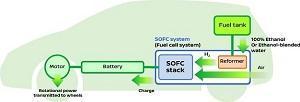 The move to ethanol would be an industry first, and would be very efficient. Nissan implied you would be able to drive at least 372 miles on a single tank. This would be competing with the Tesla Model S's estimations. The Tesla is rumored to only being able of reaching 253 miles before it needs a full recharge.
The move to ethanol would be an industry first, and would be very efficient. Nissan implied you would be able to drive at least 372 miles on a single tank. This would be competing with the Tesla Model S's estimations. The Tesla is rumored to only being able of reaching 253 miles before it needs a full recharge.
The official name of the technology is Solid Oxide Fuel-Cell (SOFC) technology. In their press release, the company said the system is powered by the e-Bio Fuel-Cell (the ethanol) and is driven by the SOFC power generator that turns the fuel into electricity.
"In addition, the e-Bio Fuel-Cell car's distinct electric-drive features -- including silent drive, linear start-up, and brisk acceleration -- allow users to enjoy the joys and comfort of a pure electric vehicle (EV).
So, it's lithium-ion vs ethanol in the future, then? Perhaps. Manufacturers are lining up to see what the preferred method of powering electric vehicles will be. However, both technologies are leading to a zero-emissions future and that's a good thing. Which technology looks most promising to you? Let us know in the comments section. You can also read Nissan's press release announcing the ethanol fuel cell: HERE
- Details
- Written by: Quintus Potgieter
- Category: Developments
Everything's bigger in Texas. Even the engines inside the big pickup trucks. However, petrol heads have become more conscious about how much fuel they consume as prices continue to dance around uneasily. It's all about fuel efficiency in the twenty-first century. However, with gas guzzling cars, getting the most out of your tank had been difficult, until now. An engineer out of Texas has claimed to have developed an engine that would be able to do 100 miles per gallon.
Cars are currently able to reach 60 miles to the gallon if the driver shuts off everything else that potentially utilises the car's energy-producing fuel, and just drives. However, Josh MacDowell, the budding inventor, has said that using a Stirling engine and thermopile technology has shown some interesting results. He has tested a hybrid electric car that
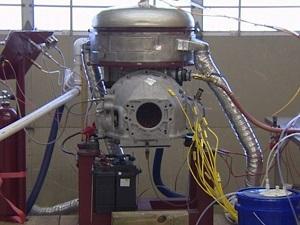
charges the car while it drives. He is venturing forward with putting one of the engines into a Ford F-150 and securing 58 miles to the gallon. MacDowell says smaller SUVs will be able to achieve 100 miles to a gallon,
Stirling engines are 200 years old and are powered by the exchange of hot and cold air. The engines are apparently able to use 50% of the power they produce, whereas the engines we use in our cars can only utilise 14% of the energy they produce.
Nonetheless, taking MacDowell's claims at face value, Texas A&M University, San Antonio, have now invested into the project, and will be assisting him in obtaining a patent for the new engine design.
Macdowell spoke to KHOU and said: "I imagine in 20 years the only place you will see an internal combustion engine is on a Harley-Davidson motorcycle because people like the way they sound. He is so confident in his new creation that he is prepared to do a cross country trip on only 40 gallons of fuel, and is expecting to achieve. He says once he achieves that the automotive industry will be knocking on his door to try and get involved with the technology.
Will the Stirling engine be the future of the automotive engine? We'll keep an eye on the news for you, and track the progress of MacDowell and his seemingly revolutionary engine.
- Details
- Written by: Quintus Potgieter
- Category: Developments
Countries like India and Africa have poverty-stricken areas with people who need food just like the rest of the world. In these impoverished areas, the burning of unstable gas stoves is commonplace, which has its own dangers due to shack fires that could occur. Burning charcoal is out of the question indoors, due to carbon monoxide. Burning a wood fire also causes unhealthy amounts of smoke if it were to be burned indoors. However, a group of engineers at a company named BioLite have banded together to bring a smoke-less clean burning wood stove, that is now available to these impoverished nations.
Additionally, the engineers have made sure that the stove is able to regulate heated and cooling temperatures with causing minimal damage to the stoves over time. The engineers say the stove can run twenty-four-seven without much damage to the pot.
So how does it work?
Ryan Gist, senior combustion engineer at BioLite. "In this lab mechanical engineers with electrical engineers and combustion engineers to develop our stoves and other products. We burn test every day and go through a lot of wood."

The answer is in the fans, which ensures more oxygen powers the fire instead of just burning the wood and creating wasteful smoke. Smoke is the indication of fuel for the fire that is being wasted and emitted, a fuel that could assist a fire in burning.
"The fan is really the heart of our home stove and camp stove products. It's important because it's doing two jobs at once. The fan is providing oxygen to the fire to make it burn clean and efficiently but it's also cooling the thermal-electric generator which allows us to make power," Gist said.
The team has 3D printed fan molds so that they can test an assortment of different fan sizes to measure how the fire can be manipulated inside the home stove. After the fans are tested they implement them into the full system.
The researchers use what they refer to as 'burn hoods' which test the amount of emissions being released by the stove. The emissions analyzers then produce data
"We measure the particulate smoke with a really cool method using a laser. By shooting a laser into the sample we can see the scatter back of the particulate smoke that's in the stream," Gist added.
The researchers claim that 90 percent of the smoke that conventional stoves produce - in poorer areas in India and Africa - is completely eliminated. The team says their target audience are the 1.2 billion people who do not have access to electricity.
"It's a really tough balancing act, the fans doing double duty, providing the air to the fire but also cooling the thermal-electric generator and you can imagine we can put more power into the fan to generate more electricity but we've taken more electricity to do that. At the same time, we have to balance the amount of air and oxygen the fire needs. It's that balancing act that we work so hard on doing in the lab," Gist said.
Source: QZ.com
- Details
- Written by: Quintus Potgieter
- Category: Developments
Fancy living in a 3D printed house? What used to be a far-fetched pipe dream might actually come to fruition sooner than you think. A Chinese company named WinSun had claimed to have printed 10 concrete houses in under 24 hours, in 2014. The company's concrete 3D printer has only been seen by employees. Therefore, there was no concrete evidence that the company factually printed the houses in under 24 hours, or even printed them at all.
As 3D printing technology progressed, the introduction of live, on site printings have increased. Dubai has printed their own office cubicle, in a construction project that took 17 days. Now, another Chinese 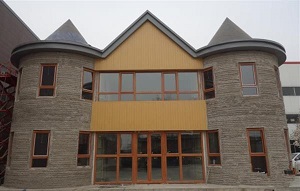 company claims to have printed a 400-square-meter villa in 45 days. The print happened completely on-site and manufactured in one place. The print is an encouraging look into the future of 3D printing houses which have been proven to be faster in construction that regular house building. The company behind the print is HuaShang Tengda Industry and Trade.
company claims to have printed a 400-square-meter villa in 45 days. The print happened completely on-site and manufactured in one place. The print is an encouraging look into the future of 3D printing houses which have been proven to be faster in construction that regular house building. The company behind the print is HuaShang Tengda Industry and Trade.
WinSun printed their parts off-site in 2014, whereas Huashang have completely printed and erected their villa out in the open. The company used C30 grade concrete with their concrete printing technology to construct the foundation and the walls.
An employee for Huashang Tengda said: "Our house 3D printing equipment combines four seperate systems: an electronic ingredient formulation system, a concrete mixing system, a transmission system and a 3D printing system. We have used a traditional reinforced concrete material to 3D print the villa, without any additives. The material does not need to be specially customized, so users can simply use locally-produced cement to greatly reduce material transportation costs."
3D printing now results in quicker build times, less labour costs, accurate structural design and efficiency across the board. 3D printing will irrevocably change civil engineering and construction for years to come as the technology is continually improved. Entire villas, offices and more are being printed, what else could we see printed in the upcoming years? The skies the limit, it seems, especially in Singapore ; the country has begun designing skyscrapers that are bound for 3D printing. Additionally, Dubai aims to print 25 percent of building projects by 2030.
Source: Engineering.com
- Details
- Written by: Quintus Potgieter
- Category: Industry
Cybersecurity for Automation, Control and SCADA systems is becoming one of the most important fields of study in the world today. The industrial world is moving towards Industrie 4.0 and the internet of things, interconnecting entire industrial companies and syncing them to cloud-based solutions. Cyber-criminals are actively making hundreds of thousands of dollars every single day from holding the data from these industries ransom.IBM Security has released a report of how much hacking is costing the cyber security industry. The report revealed that a major data breach could see companies parting with $4 million per data breach.
Globally, cyber crime is accounting for $400 billion per year, according to British insurance company, Lloyd. The United States government has secured $14 billion to combat cyber security attacks in the country that could save the data of countless companies. Studying toward a cyber security qualification could see an engineer or IT specialist making a pretty penny with ensuring that  industries remain safe from cyber crime. We recently reported that cybersecurity education in the United States specifically is not up to scratch. Hopefully, the money budgeted will go towards the educating of cyber security professionals.
industries remain safe from cyber crime. We recently reported that cybersecurity education in the United States specifically is not up to scratch. Hopefully, the money budgeted will go towards the educating of cyber security professionals.
"Cybersecurity incidents continue to grow in both volume and sophistication, with 64 percent more security incidents reported in 2015 than in 2014," said Amanda Carl, IBM's corporate communications officer.
Their report further indicated that noticing a breach could take up to 201 days and the containment of a breach could take up to 70 days, on average.
IBM's CEO and President Ginni Rommety said: "We believe that data is the phenomenon of our time. It is the world's new natural resource. It is is the new basis of competitive advantage, and it is transforming every profession and industry. If all of this is true - even inevitable - then cyber crime, by definition, is the greatest threat to every profession, every industry, every company in the world."
The Dean of Engineering at the Engineering Institute of Technology, Steve Mackay, said that his institution sees 10 to 20 attempts at infiltrating their online systems every week. He confirmed this in his YouTube series, the Engineering News Network. He goes on to explain that industrial networks are vulnerable and expressed dismay surrounding the shortage of cyber security experts. He said: "Industrial networks for your PLCs and other hardware used to be proprietary. Now, they're open with ethernet,TCPIP and of course, are a whole lot more vulnerable to hacking. We all access the cloud now, which means that your information has to traverse a very public network, so it raises your profile in terms of attacks. We need to design - into everything we do, both individually and holistically - some sort of cyber security. So, concepts such as security in depth, you need to understand and apply to your systems"
The IBM report further indicated that companies who invested into cyber security companies to prevent or remedy cyber crime have saved the companies $400,000. IBM found that data breaches that were remedied in 100 days only cost companies $3.23 million. Data breaches discovered before 100 days only cost $1 million.
The real question is: Is $14 billion enough investment into the research of cyber security, that claims $400 billion of damage every year? Let us know in our comments section.
Source: IBM
- Details
- Written by: Quintus Potgieter
- Category: Developments
Data communications just got a bit more interesting thanks to lasers. Visible light communications abbreviated as VLC - no not the video player - is a technology that utilizes visible light to carry data from one device to the other, unlike radio frequencies that are used today. A new paper on the subject has been published in the ACS Photonics journal. The authors are from the King Abdullah University of Science and Technology (KAUST).
VLC technology makes use of lasers or LEDs which appear as normal lights. The catch is that the lights are turning on and off faster than the human eye can observe. Reportedly, the light sends data in binary code to a receiver that deciphers it. A converter changes the laser light into colors that 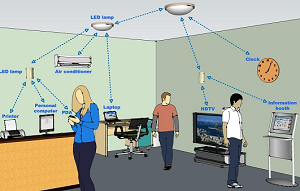 receive the transmission and decodes into "white light" that then captures the data being sent.
receive the transmission and decodes into "white light" that then captures the data being sent.
Osman Bakr, one of the researchers on the team developing a VLC color converter, said: "In this work we break the record for data communication using visible light, and more impressively produce white light with a very high color rendering index of 89, by designing a special color converter based on hybrid perovskite nanocrystals. Our work demonstrates white light as both a lighting source and a system for ultra-high-speed data communications."
The researchers' color converter allegedly has 40 times the bandwidth for transmission, compared to already available commercial converters. The team was able to reach 2 gigabits per second, trumping data transmission technology like WiFi.
"In this bandwidth-hungry era, there will be a continuous push by consumers for VLC systems with higher bitrates. We believe that white light generated by semiconductor lasers will one day replace the LED white light bulb for energy-efficient lighting. To achieve this objective, we set our long-term goal to develop nanocrystals that can convert high-energy excitation photons from the semiconductor lasers to Red-Yellow-Green-Blue (RYGB) lights at ultra-short photon lifetime," said Boon Ooi, one of the researchers and inventors behind the new converter.
The future of smart lighting that could produce data connection points which could transmit data to devices could be here sooner than we think. Engineers have been working on Li-Fi technologies that would make this possible. However, visible light communication could replace Li-Fi as a data transmitter in buildings with lighting fixtures, without the need of radio frequencies.
Source: PHYS
- Details
- Written by: Quintus Potgieter
- Category: Education
Australia's Productivity Commission has spoken out against political parties who have encouraged students to pursue STEM subjects in school. The Commission says the $48 million project was "wrongheaded" and only added to the number of unemployed graduates in the country. The qualm is that the parties are trying to shape a market without letting it run its own course.
The Labor Party have said that STEM graduates are not doing well with regards to finding jobs in Australia. According to The Australian, the only STEM degree graduates that are faring well, are the ones in the following industries: Healthcare, Mining Engineering, and Surveying.
The Productivity Commission have outlined the issues graduates face today:
- Employment opportunities improve after three years of graduation
- 20% of graduates in natural and physical sciences have do not have jobs
- 1/4 of science degree holders say they are currently doing a job that does not require their degree
- Graduates who studied outside of the science realm utilize the skills and knowledge they gained during their degree, whereas science degree holders cannot say the same
- 30% of IT degree holders also report that they do not utilize their degree in their current jobs
 Are the engineers getting the jobs? Some might be, however, there is also a growing number of engineering PhD graduates that have reported the volatility of the job market in Australia right now.
Are the engineers getting the jobs? Some might be, however, there is also a growing number of engineering PhD graduates that have reported the volatility of the job market in Australia right now.
Elsewhere, at the U.S. News STEM Solutions Conference, the executive director of the Seattle Jobs initiative, John Kim, said that STEM is critically important for "living wage jobs" in the country. He said that positions are getting harder to fill in the STEM industries. The senior director of Replication and Strategic Partnerships at the Jane Addams Resource Corporation, Manny Rodriguez, said that 650,000 manufacturing jobs are not being filled, every year.
Governments should be filling the disconnects between what degrees are teaching and what jobs are requiring. If 650,000 manufacturing jobs go unfilled, but are available, then a university somewhere is teaching the wrong curriculum.
- Details
- Written by: Quintus Potgieter
- Category: Industry
Researchers at the Massachusetts Insitute of Technology have tackled one of the biggest questions plaguing the engineering industry: Where are all the women? The last two years have been landmark years for universities that have prioritised closing the gender gap that exists in the engineering world. Some universities ensure to have at least 30 percent female attendance in their engineering courses. Some universities have even ensured that half of the classes are female. However, aside of the strides being made in getting women into engineering, MIT has found that some issues arise once they have arrived in the industry, as well. The researchers took a look at why women leave engineering.
We recently reported that Engineers Australia's study into gender gaps in engineering said that less than 1% of Australian women past the age of 50 years old are currently working in the industry. Meaning, the other women who used to work in the industry had all left the industry before the age of 50. According to the Telegraph, only 9% of the United Kingdoms' engineering workforce is female. Furthermore, Jobsite's study into female engineering saw that there are three times the number of female engineers in the 20-24 age bracket than there are in the 40-44 bracket.
 Susan Silbey, a Professor of Humanities, Sociology and Anthropology at MIT with regards to the engineering industry, said: "It turns out gender makes a big difference. It's a cultural phenomenon." The paper she co-authored is titled: Persistence is Cultural: Professional Socialization and the Reproduction of Sex Segregation. The report focuses on engineering relatively closely, revealing that women become "disillusioned with their career prospects" once they aim to achieve big goals in the engineering industry.
Susan Silbey, a Professor of Humanities, Sociology and Anthropology at MIT with regards to the engineering industry, said: "It turns out gender makes a big difference. It's a cultural phenomenon." The paper she co-authored is titled: Persistence is Cultural: Professional Socialization and the Reproduction of Sex Segregation. The report focuses on engineering relatively closely, revealing that women become "disillusioned with their career prospects" once they aim to achieve big goals in the engineering industry.
They also crunched the numbers and unveiled their results in the report:
- Women account for 20 percent of undergraduate engineering degrees
- 13% of the engineering workforce is female (U.S.)
The research included the study of 40 undergraduate engineering students who wrote in diaries twice every month. They had 3,000 diary entries to peruse and generate data from. What they found is that when female engineers are involved with team-based activities outside of the lecture halls, gender stereotypes run rampant.
One of the diaries that detailed a robot-designing brainstorming session, showed what kind of gender discrimination occurred: "...two girls in a group had been working on the robot we were building in that class for hours, and the guys in their group came in and within minutes had sentenced them to doing menial tasks while the guys went and had all the fun in the machine shop. We heard the girls complaining about it..."
Source: MIT News
- Details
- Written by: Quintus Potgieter
- Category: Industry
The International Energy Agency has released their report on liquefied natural gas and how the market is growing. The report, titled 2016 Medium-Term Gas Market Report, says that investment into LNG will grow the market by 45% between 2015 to 2021. Australia will be a big producer, along with the United States, however after Shell's announcement of a slow-down on a lot of projects, the market is looking volatile. The report also stated that global natural gas demand would increase by 1.5% annually, which is an estimation that differs from the previous measurement of 2% growth. One of the bigger importers of LNG, with a huge increase in demand, is China.
 China's demand for LNG would grow by 15% between 2016 to 2021, this according to a report compiled by TechSci. The report was titled 'China LNG Market Demand & Supply Analysis, By End-User, By LNG Terminals Forecast and Opportunities, 2011-2021'
China's demand for LNG would grow by 15% between 2016 to 2021, this according to a report compiled by TechSci. The report was titled 'China LNG Market Demand & Supply Analysis, By End-User, By LNG Terminals Forecast and Opportunities, 2011-2021'
"Government of China prioritized expansion of natural gas based power plants, on account of growing air pollution and rising greenhouse gas emissions. This is boosting installation of new natural gas-based power plants along with LNG terminals, especially in Guangdong and Shangai provinces of the country. In order to reduce coal consumption, Beijing has already replaced four major coal power plants with natural gas. In the coming years, the government is planning to replace all coal-based power plants in the country with natural gas based power plants. This shift towards natural gas based power plants is forecast to propel growth in natural gas exploration and production, as well as augment China's LNG imports in the coming years," said Mr. Karan Chechi, Research Director with Techsci Research.
China is the third biggest importer of LNG in the world, behind Japan and Korea, says TechSci.
- Details
- Written by: Quintus Potgieter
- Category: Education
At the risk of sounding like a broken record, we once again have to repeat that augmented reality is coming to engineering and in a big way. Recently, we have been talking about how the Microsoft Hololens could factor into engineering industries, specifically in construction. Now, engineering firm, Aecom, has confirmed our rumors. They will be running a "pilot project" that will see engineers using the "mixed-reality" goggles on construction projects.
Integrating mixed reality into construction sites means that you could see the finished product in front of you, how tall it is going to be, how wide it is going to be, what needs to be secured and will give you an  idea of what needs to happen before construction begins.
idea of what needs to happen before construction begins.
The president of Aecom, Stephen Kadenancy, said: "With this technology we can gain clarity earlier in the design review process than with 2D drawings or 3D models on screen, and team members in different locations, each wearing a headset, can simultaneously explore the same holographic projections."
The move by the engineering firm shows that there is a need for a holographic engineering design process that would improve a product or even building design before any actual work begins. Aecom will be integrating Trimble software which would allow the engineers to view structures on a table surface in augmented reality.
"Exploring complex structures in a mixed reality environment has a huge potential to accelerate the engineering design process," said Kadenancy. Perhaps your engineering career could be improved by the use of mixed reality applications, that could root out issues before they arise during the construction process.
Aecom will be testing the Hololens in London, Hong Kong, and Denver, according to V3.
- Details
- Written by: Quintus Potgieter
- Category: Developments
Australia is now powering an entire gold and copper mine with solar energy. The DeGrussa mine in Western Australia is powered by one of the largest off-grid solar and battery storage facilities in Australia. The photovoltaic cells are producing 7MW of electricity and will reach 10MW by the end of summer. The plant will serve as a test for the implementation of clean energy powering of other mines around the world.
According to Mining Weekly, the project cost the mine $40 million. The hefty price has bought the mine the latest in photovoltaic technology and saw 34,080 photovoltaic cells being delivered to the mine. The  panels reportedly have a tracking system that follows the sun during the day.
panels reportedly have a tracking system that follows the sun during the day.
The panels are hooked up to the storage units that stores up to 6MW of energy. This would eliminate some of the emissions that their diesel powered station produces. The official number given by Sandfire was that 12,000 tonnes of carbon dioxide emissions would be eliminated which was a reduction of 15%. Additionally, five million litres of diesel will be saved per year.
"This project has already attracted a significant amount of interest from within the mining industry in Australia with Sandfire receiving inquiries from several of our peers interested in adopting this technology at their mine sites. I would not be surprised to see more facilities like this built over the next few years, as the benefits and potential of solar power become increasingly recognised across the resource sector," said Karl Simich, Managing director and CEO of Sandfire, the company that owns the DeGrussa mine.
- Details
- Written by: Quintus Potgieter
- Category: Developments
Bloomberg has put together a new report named New Energy Finance's New Energy Outlook 2016. In the report, the group estimates that the renewable energy market will have grown to its optimum rate by then and energy storage systems will be available and affordable to all.
In the report, the group said: "Cheaper coal and cheaper gas will not derail the transformation and decarbonisation of the world's power systems. By 2040, zero-emission energy sources will make up 60% of installed capacity. Wind and solar will account for 64% of the 8.6TW of new power generating capacity added worldwide over the next 25 years, and for almost 60% of the $11.4 trillion invested."
The group detailed very likely scenarios that will lead to renewables winning the war for energy production based on recent advancements in clean, renewable energy production:
- Coal and gas prices to stay low
- Wind and solar costs fall sharply
- Fossil fuel power attracts $2.1 trillion
- BUT $7.8 trillion invested in green power will trump that
- Electric car boom: Norway is already talking about banning fossil fuel powered cars
- Home energy storage units: Tesla, Daimler AG, Nissan, RedT, Apple. Companies that will be supplying lithium-ion house-powering batteries.
- Coal industry will start to suffer
- Europe is already on board: Portugal has tested 4 days of full renewable power, Germany is using more renewable power, Britain is actively starting utility balancing energy production.
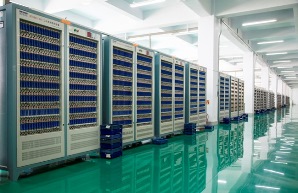 However, with everyone jumping on the bandwagon at the same time, and a host of technologies available. Who gets the vote of confidence from consumers? Even more importantly, who does government put their trust in?
However, with everyone jumping on the bandwagon at the same time, and a host of technologies available. Who gets the vote of confidence from consumers? Even more importantly, who does government put their trust in?
"Researchers and practitioners have struggled to compare the costs of different storage technologies because of the multiple dimensions of cost and the fact that no technology dominates along all dimensions. Storage technologies can only be compared by looking at the contexts they are going to be used," said Professor of Energy Studies at MIT Jessica Tranick. She said this in the context of a new study that MIT conducted which evaluated which form of clean energy technology is currently being invested into most.
Her research took place in three areas: Texas, California, and Massachusetts. Her research concluded that storage systems had made the most economic sense in the area. Tranick said: "The best technology in one location is also the best in the other. This is because of the similarity across locations in the distribution of the duration of electricity price spikes."
To read more from her study, you can head over to the MIT News website.
- Details
- Written by: Quintus Potgieter
- Category: Education
Computer science or computer engineering? What are the differences? Okay, another question: Computer science & engineering or Electrical & computer engineering? The difference could lead you into a different job.
The first difference, according to PayScale's College Salary Report of 2016, is the salary. Computer science & engineering students will make $69,100 in early career pay with a bachelor's. Electrical & computer engineering (ECE) will make $67,000 in early career pay with a bachelor's. So, pretty equal. The National Association of Colleges and Employers (NACE) reported that the salary for a bachelor's degree in computer science degrees  had reached $61,321 in their findings. However, that is for students who did only computer science and mathematics, without engineering involved. When engineering and computer science meet, salaries go up by $7,779.
had reached $61,321 in their findings. However, that is for students who did only computer science and mathematics, without engineering involved. When engineering and computer science meet, salaries go up by $7,779.
So why the significant pay gap? It's how the work is divided between computer science degrees without engineering and degrees that include it all. Below, are the different kinds of tasks the curriculum's might have by themselves. When they are combined, the starting salary goes up.
| Computer Science | Computer Engineering |
| Creating software that makes hardware run | Designing the physical hardware - Hardware based |
| Programming and developing | Physical electrical components |
| Write code | Electrical engineering and computer engineering go hand in hand |
| Design operating systems | System design |
PayScale also admitted that STEM careers were the highest earning in their College Salary Report.
However, the Computer Science Education Coalition says that students should strongly consider doing computer science focused degrees due to the amount of jobs that are now available to them.
"Not only does computer science provide every student foundational knowledge, it also leads to the highest-paying, fastest-growing jobs in the U.S. economy. There are currently over 500,000 open computing jobs, in every sector, from manufacturing to banking, from agriculture to healthcare, but only 50,000 computer science graduates a year," said the Computer Science Education Coalition.
Techcrunch says that students who had studied computer engineering and embedded systems degrees are making the transition into web and mobile development due to the impending move to the Internet of Things the world is making. Therefore, any computer-based degree is becoming more and more attractive, but focus on software creation (that computer science is synonymous for) is something that even the engineers are having to become proficient in.
- Details
- Written by: Quintus Potgieter
- Category: Developments
Battery-less technologies are in our future. It's all about the Internet of Things and interconnecting devices. The thinking is that if IoT devices didn't have the need for a battery charge they could stay connected forever because the battery wouldn't run out and need to be recharged. The only way this would be possible is with energy harvesting. Instead of getting a charge from a battery, you would get the direct charge from something like solar power or wind energy. Some devices and utilities are soon going to be using kinetic energy producing sources as well. However, there is an overlooked source of energy that electrical engineers are now actively working with. Electromagnetic energy.
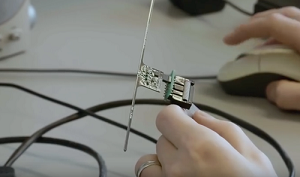 Now, a group of researchers is researching how to tap into the energy that electromagnetic energy produces. This would including converting radio waves into battery-charging power.
Now, a group of researchers is researching how to tap into the energy that electromagnetic energy produces. This would including converting radio waves into battery-charging power.
Dr Przemyslaw Pawelczak currently conducts research into the batter-free computers field of electrical engineering at the University of Washington.They have announced a battery-less computer named WISP )Wireless Identification and Sensing Platforms). The computer they have created works on harvested radio waves. He said: "Our vision is to have truly wirelessly programmable, software-defined, battery-less computers wherever and whenever you want. Imagine the possibilities." The device would use RFID (Radio Frequency Identification) and then energy-harvest the waves and convert them into electricity. The University of Washington is working with the Delft University of Technology and have filed a patent for the device.
According to insider sources, the WISP currently has equal processing power when compared to the Fitbit fitness trackers that are currently available. There are rumors that Apple and Microsoft are working on the same technologies.
Source: EE Times
- Details
- Written by: Quintus Potgieter
- Category: Developments
Engineers have to keep their eyes on what scientists are doing. Why? Because scientists could bring a new compound to the world that engineers have to factor into their designs. You never know what could be coming out of a lab next. One of these 'new-age' materials engineers could be seeing on a daily basis is graphene. Graphene is being researched closely around the world in many labs. The hope is that graphene can be engineered into many industries where strong, highly conductive, bendable materials are needed. That is what the Massachusetts Institute of Technology (MIT) has been experimenting with.
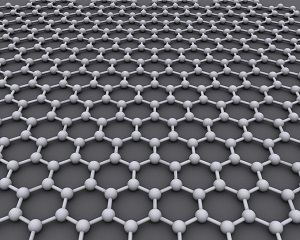 Graphene, discovered in 2004, is a 2D material that is stronger than steel and far more lightweight. The prospect of using it is exciting engineers, but the research hasn't produced much promise yet.
Graphene, discovered in 2004, is a 2D material that is stronger than steel and far more lightweight. The prospect of using it is exciting engineers, but the research hasn't produced much promise yet.
Researchers at MIT say they made a breakthrough with a sheet of graphene and electricity. They have now concluded that a flow of electric current can "exceed the speed of slowed-down light" and achieve a phenomenon they are comparing to a sonic boom an airplane would create. They are calling it an optical "boom". According to the researchers, they are allegedly converting electricity into a visible radiation which can be controlled and is fast and efficient.
"Graphene has this ability to trap light, in modes we call surface plasmons. Plasmons are a kind of virtual particle that represents the oscillations of electrons on the surface. The speed of these plasmons through the graphene is a hundred times slower than light in free space," said Ido Kaminer, an author of the paper that he and a team published about these breakthroughs with graphene.
However, graphene along with the ability to trap light may also be able to generate light. Marin Soljačić, a professor of physics at MIT, explained: "This conversion [slowing down light on graphene sheet] because the electronic speed can approach light speed in graphene, breaking the 'light barrier'. Just as breaking the sound barrier generates a shockwave sound. In the case of graphene, this leads to the emission of a shockwave of light, in two dimensions. If this research goes any further we may see some movement in a light generation technology to compete against LED technology.
The researchers say that the generating of plasmons can theoretically be performed on microchip technology that exists today. This could have far-reaching benefits for electronic technology. Soljačić says that the implementation of graphene into microchip technology is theoretical right now. He said: "I have confidence that it should be doable within one to two years."
Source: MIT
- Details
- Written by: Steve Mackay
- Category: Blog - Steve Mackay
It is always worth remembering that our engineering skills can dramatically help many of our fellow world citizens living in poverty and horrendous conditions. For example, a billion people don’t have safe drinking water and two billion do not have sanitation, resulting in enormous disease and a high death rate – particularly for kids.
Dear Colleagues
It is always worth remembering that our engineering skills can dramatically help many of our fellow world citizens living in poverty and horrendous conditions. For example, a billion people don’t have safe drinking water and two billion do not have sanitation, resulting in enormous disease and a high death rate – particularly for kids.
Inspirational Engineering
An inspirational engineer in this regard is Amy Smith of MIT. For someone who hasn’t driven a car, Amy Smith, is doing remarkable things with her hundreds of mechanical engineering students, working on real projects to apply simple technology to help the rural poor. She feels there is an urgent need to help the billions of people who don’t have safe water, sanitation and enough food.
Recent projects included a high pressure hand-press for making charcoal briquettes from sugarcane waste and a vibrating compactor to make bricks from soil, a bicycle powered chlorine generator to purify water and batteries made from aluminium cans, charcoal and salt water (the last one sounds rather suspect, but there you go). She avoids foisting high flying advanced technology on the locals but tries to give them the know-how to create their own solutions.
Western Technology is Everywhere
As you well know, Western style technology is reaching out throughout the world. Even in the poorest villages, you will see an internet café somewhere. Afghanistan had 15,000 mobile phones in 2002; now that figure has grown 40-fold. Solar panels are stuck haphazardly on the thatched roofs of the huts of a Kenyan village.
However a lot of western technology and engineering is simply not appropriate for a poor country. Massive western-style infrastructure projects (such as power stations and gigantic dams) have not necessarily delivered to the poor. And many western technologies are simply bad news for poor. Highly sophisticated manufacturing plants can’t run without a sophisticated supporting infrastructure and skills base. Chemical pesticides on farms require strict health and safety rules which are ignored due to language and conceptual difficulties.
However, I don’t think we should focus on blaming someone for these issues, but look aggressively for workable alternatives. The other challenge is that labour is cheap in developing countries so western style capital-intensive automated manufacturing requiring minimal labour just doesn’t stack up.
Successful Micro Projects
To give you some flavour of what I am talking about in engineering, some successful micro-projects are:
- A machine to turn industrial waste into roof tiles
- Solar powered ovens
- Micro-hydroelectric plants on small rivers
- Solar water heating
- Machinery to turn weeds into paper
- An elephant pump – drawing water up from a deep well using plastic washers knotted to a loop of rope running through a pipe
- Eco-san toilet which doesn’t require conventional sewer systems
- Solar powered lanterns for lighting homes and villages
A few suggestions:
- Look for ways to apply your engineering skills appropriately in poorer countries
- Encourage local colleagues to do the same
- Transfer your engineering know-how freely to others
- Mentor students and people from less advantaged backgrounds esp. from poorer countries
- Encourage your universities and colleges to embark on projects in other poorer countries
- Actively look at how you can simplify your high tech products and services to be applicable in less fortunate countries
- Support your local engineering association’s efforts in this regard (e.g. RedR)
To modify John Kennedy’s famous request: And so, my fellow engineers: ask not what your engineering skills can do for you—ask how you can apply them in the service of your fellow less fortunate citizens throughout the world.
Yours in engineering learning
Steve
Mackay’s Musings – 14th June’16 #604
780, 293 readers – www.eit.edu.au/cms/news/blog-steve-mackay
- Details
- Written by: Quintus Potgieter
- Category: Developments
Why should you care about the continual engineering of Bluetooth? Because it could be helping your automated factory very soon. Bluetooth is about to have twice the speed it previously did and it will also have four times the range. They're calling it Bluetooth 5. The announcement comes from the Bluetooth Special Interest Group. The group says that the new iteration of the technology would assist in accelerating "industries such as industrial automation, smart infrastructure, smart homes and location-based services."
 Mark Powell, Bluetooth SIG executive director, said: "By adding significantly more capacity to advertising transmissions, Bluetooth 5 will further propel the adoption and deployment of beacons and location-based services to users around the world. It's a great story and one we're looking forward to telling from our upcoming media event in London on June 16."
Mark Powell, Bluetooth SIG executive director, said: "By adding significantly more capacity to advertising transmissions, Bluetooth 5 will further propel the adoption and deployment of beacons and location-based services to users around the world. It's a great story and one we're looking forward to telling from our upcoming media event in London on June 16."
The group is confident that Bluetooth will factor into the Internet of Things in a big way. Bluetooth wireless technologies are reportedly already being used as a preference of communication between sensors in some factories. A group named IMS Research published a report that revealed Bluetooth technology accounted for "more than half of all wireless-enabled industrial automation equipment shipped in 2012." The report concluded that 22 percent of the market used Bluetooth technologies and 31 percent used WLAN solutions. Now, with the advancement of Bluetooth, the number of automated industrial complexes using the technology could grow.
Information Week reports that 3 billion devices sent out per year have the Bluetooth technology built into them.
- Details
- Written by: Quintus Potgieter
- Category: Developments
A solar-powered plane prototype flew over New York on Friday night. The aircraft was tested by a company named Luminati Aerospace LLC. The company allegedly wants to build a fleet of drones that would be able to provide internet access for 4 billion people worldwide. A fleet of internet supplying, constantly hovering drones? Interesting. The plane's name is Solar Impulse 2 and is considered to be the largest solar-powered aircraft on the planet. The plane was flown over Long Island.

CEO of Luminati, Daniel Preston, said: "This is a dream come true. Long Island is known as the Cradle of Aviation, and we want to do our part to keep it here where it belongs."
They spent 20 minutes up in the air controlled by pilots. The end game for the project is to have a fully automated solar-drone that would be able to fly at 60,000 feet, according to Luminati.
Preston is confident that the preliminary tests of these kinds of solar planes will lead to a better understanding of what to do in the future. They want to apply what they have learned to the solar-powered, internet-providing drones.
"I really can't think of any engineering project today that has a greater social impact than bringing communications for many people in the world that don't have it," Preston said.
Check out the video below for the test-flight footage:
- Details
- Written by: Quintus Potgieter
- Category: Developments
Researchers at the University of Kentucky have unveiled longwall shearers that also have scrubber systems attached to them which minimize the amount of coal exposure to miners. Shearers extract coal from coalfaces and according to the researchers account for 50% of all the coal produced in the world today.
Thomas Novak and Chad Wedding work with the University of Kentucky Department of Mining Engineering Alliance Coal. Novak said that mining operations, unlike longwall mining, have used what are called flooded bed scrubbers in the industry. What their study consists of is bringing mining technology from one kind of engineering to
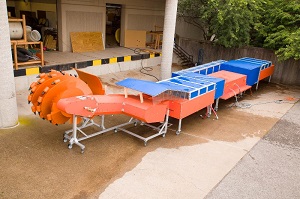
another kind of engineering to minimize the amount of dust that is produced by longwall shearing. So they set out to implement scrubbers into a longwall shearer.
The researchers have 3D printed molds for the scrubber parts of the longwall shearer and the rest of the shearer was built in University of Kentucky's "machine shop".
Upon completing a prototype 3D printed small-scale version of the shearer, the researchers are confident they can print a full 65-foot full-scale model. The model will have to go through a round of safety tests to measure whether or not the shearer is ready to be put to work. The researchers could set a new precedent for 3D printing parts for mining efforts.
An Australia mine is also getting their own longwall mining system from Caterpillar. The Moolarbean Coal Complex will receive the machine and will start extracting coal in the New South Wales area. This, after a string of other longwall systems proved their efficiency elsewhere in Australia. What makes the specific longwall system special is that it can be controlled by "advanced automation control". The newer technology includes Horizon Control, Extraction Control and Face Alignment which all contribute to more efficient coal extraction. The system is said to be in operation by 2017.
To see how CAT longwall systems work, check the video below:
Source: Mining Technology / Engineer Live
- Details
- Written by: Quintus Potgieter
- Category: Education
There is an engineering employment problem in Africa. We recently reported on South Africa engineering graduates that had taken to the streets with cardboard signs and begged passing motorists for jobs. The two graduates that had gained some social media fame both has their honours in chemical engineering. Now, in Kenya, a graduate with his bachelor of science in electrical engineering and a diploma in project management has begged for a job as well.
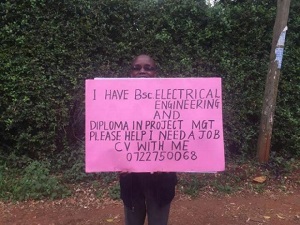 His name is Gilbert Mutai. He received his BSc through Kenya's Technical University and is now unable to find work after graduating.
His name is Gilbert Mutai. He received his BSc through Kenya's Technical University and is now unable to find work after graduating.
The World Economic Forum, in a 2014 report, said that South Africa had the third highest unemployment rate in the world between the ages of 15 and 24.
The executive director of the SA Graduate Employers Association, Cathy Sims, spoke to IOL about the government's intention to work more closely on graduate programmes that could lead to employment for graduates. She said: "I certainly, having worked in the sector for the last 20 years, have seen a significant increase in employers actively pursuing entry level candidates. We have been measuring the growth of demand for graduates in our research since 2007 and the demand has more than doubled in eight years at our member organisations. On the other hand, there are also many companies that need trained technical professionals - be they engineers, accountants or lawyers. They will typically be placed into a position, provided with on-the-job training and fill meaningful roles."
The problem is not limited to Africa, not by any means.
The Chartered Institute of Personnel and Development (CIPD) in the UK conducted a study that included engineering graduates. They find that 58.8 percent of UK graduates had found work during the 2008 recession...but in non-graduate jobs. This means they worked in retail or something similar, an industry that did not require their degree.
"There's a need for universities to give these groups more targeted support in making the transition from study to employment. And employers need to change their perceptions to avoid squandering talent," said Sally Hunt, general secretary of the University and College Union in the UK. [Via: Telegraph]
Finding employment in the engineering industry is becoming harder and harder. What experts are instructing graduates to do is, is equip themselves with non-engineering skills like entrepreneurship, writing skills and the likes so that they are more attractive to employers. However, if a Kenyan student who has both his BSc in electrical engineering and a diploma in project management can't get a job, there is a definite problem that needs to be addressed in the country itself.
Source: Hivisasa
- Details
- Written by: Quintus Potgieter
- Category: Industry
The Fortune 500 list for 2016 has been released. The list details 500 companies that make up two-thirds of the United States' gross domestic product. The companies posted $12 trillion in revenues and $840 billion in profits, according to Fortune. However, due to a volatile construction and oil year, how are engineering companies coping?
The top 10 on the Fortune 500 should give you a pretty good idea of where the top-paid engineers are working:
- Walmart
- Exxon Mobil
- Apple
- Berkshire Hathaway
- McKesson
- UnitedHealth Group
- CVS Health
- General Motors
- Ford Motor
- AT&T
 Most notably, Exxon Mobil and Apple are very close to the top. Oil and gas and electronics seem to be ruling the roost right now. Also, those are two companies that are going to be spending money on renewable energy and the creation of new branches within their companies.
Most notably, Exxon Mobil and Apple are very close to the top. Oil and gas and electronics seem to be ruling the roost right now. Also, those are two companies that are going to be spending money on renewable energy and the creation of new branches within their companies.
However, last year, engineering companies who have a keen focus on construction in the makeup of their companies went up on the Fortune 500 list in a successful 2015. The guys over at Construction Dive compiled a list of which engineering companies had made it to the Fortune 500 and stayed there over the years:
| Company name | Revenue | Profits | Number of employees | Rank of last year | Years on Fortune 500 list |
| Jacobs Engineering Group | $12.115 billion (down 4.6%) | $303 million (down by 7.7%) | 56,950 | 239 (up 4 spots) | 16 |
| Peter Kiewet Sons' | $8.992 billion (down 12.4%) | $251 million (down 28.3%) | 22,000 | 286 (drop of 28 spots) | 17 |
| Quanta Services | $7.632 billion (down 2.8%) | $311 million (up 4.8%) | 24,500 | 361 (up 9 spots) | 4 |
| EMCOR Group | $6.723 billion (4.3%) | $172 million (up 2.1%) | 29,000 | 421 (up 40 spots) | 16 |
| CH2M Hill | $5.362 billion (down 1.0%) | $80 million (unchanged) | 22,000 | 480 (up 2 spots) | 8 |
The company that jumped up a staggering 40 spots was EMCOR Group. With sixteen years on the Fortune 500 list, the company improved their revenue and profits in 2015.
The company that gained the second most ground was Quanta Services, which went up 9 spots compared to the previous year. They are based in Houston, Texas and capitalize on the oil industries that are prevalent in the area. The shareholders said that the "drop in revenue" they experience was caused by the current demand for oil, which they could not control.
2016 should be an interesting year for these companies due to construction slow-downs on new orders. U.S. construction is posting its lowest numbers in five years. With construction and oil struggling to recover in 2016, we could see these companies post even lower results. However, ExxonMobil seems to be coping in the tougher industry, being second on the top ten list of Fortune 500. What is apparent is that companies like EMCOR and CH2M are very close to losing out on their Fortuen 500 status as engineering companies with focus on construction and engineering.
- Details
- Written by: Quintus Potgieter
- Category: Developments
The rumor mill is working around the clock when it comes to talking about Apple. The iPhone manufacturer has been named - multiple times - in rumors that indicate that they have scooped up former engineers from Tesla. The media has basically outright confirmed that Apple is building an electric competitor to Tesla and other companies in the electric vehicle industry.
 Reuters did their very own investigating and found out the latest on the very behind-the-scenes progress Apple is making. A host of LinkedIn profiles were investigated and revealed that engineers who have worked with electric vehicle charging stations are now working at Apple. Apple declined to comment on the existence of an electric car project or that they had hired engineers to fine comb a new charging method for electric vehicles. The rumors are that the car will also be self-driving.
Reuters did their very own investigating and found out the latest on the very behind-the-scenes progress Apple is making. A host of LinkedIn profiles were investigated and revealed that engineers who have worked with electric vehicle charging stations are now working at Apple. Apple declined to comment on the existence of an electric car project or that they had hired engineers to fine comb a new charging method for electric vehicles. The rumors are that the car will also be self-driving.
Could we be seeing Apple enter the energy storage business as well? One of the LinkedIn profiles turned out to be Rónán Ó Braonáin, an engineer who used to work for BMW, specialising in electric charging and home energy systems.
Nonetheless, we may soon be seeing an announcement of the intentions to build a car at Apple's WWDC 2016 conference, although it is unlikely. What can be confirmed is that Apple has been given the go-ahead by North Carolina to turn emissions from landfill waste into electricity. They will be working with Catawba County and will construct a renewable energy facility. They have the lease for 16 years.
They're also working with solar. Apple recently set up a solar energy branch in their company named Apple Energy LLC. Apple will sell "surplus solar power" on markets across the United States. They will have 521 megawatts of clean energy to part with due to their possession of energy farms.
Apple has also revealed that they currently power 463 Apple stores in 13 countries with renewable energy. This was published in the company's 2016 Environmental Responsibility Report.
- Details
- Written by: Quintus Potgieter
- Category: Developments
Don't you just hate folding clothes? Yeah, me too. It's something you're either good at or bad at. Don't worry about learning how to fold the perfect shirt - close those YouTube tutorial tabs, young newlywed - a robot is available to solve the problem for you. A group of engineers has released the FoldiMate.
All you do is add your favorite fabric softener and then let the machine do its work. Watch the video below and see if you can control the urge of going to their website and getting your preorder in for the FoldiMate.
Unfortunately, right now, the FoldiMate can't help with bed sheets, and it can't help with socks or small garments either. Oh well. Nonetheless, the company maintains: "FoldiMate is like having a friend that folds the laundry for you. All you have to do is easily feed it using our patented Easy Clipping technology with takes about 3 seconds."
It takes 15 to 20 items of clothing at a time, and if you add too any items, it will shout at you. The team behind FoldiMate hope to have the robot released and in your living room by 2018. It will cost "between $700 and $800".
So, if folding clothes genuinely perturbs you enough to part with $800, then consider yourself a proud owner of the FoldiMate. Check the video out. You'll want one.
- Details
- Written by: Quintus Potgieter
- Category: Developments
Are you an engineer who works with materials that expand upon contact with heat? Well, a new discovery might put you out of your misery soon. If you think about materials that expand when hot, a long list of vehicles, aircraft, roads and even electronics could be compiled.
However, Oxford University scientists have been testing negative thermal expansion (NTE) materials. So, this would mean when a material comes into contact with heat, it contracts. The study into NTE materials has been touch-and-go for some years, however, the team of researchers at Oxford's Department of Chemistry say they have made a breakthrough.
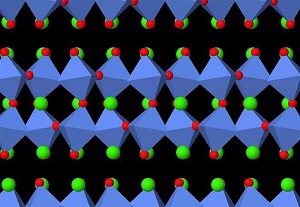
With collaboration with Imperial College, the teams have developed a material that can be chemically altered to expand or contract in reaction to a predetermined temperature. The researchers are confident that their discovery will have positive effects if applied to electronics specifically.
"The discovery of how to control thermal expansion in these materials is very exciting. Our understanding of the processes underlying the effect means that we can search for it in related materials in the perovskite family or in other classes of materials with wide applications," said Dr Arash Mostofi, one of the researchers in Imperial's Department of Materials and Physics said.
The researchers say they are now able to manipulate the atoms vibrating in the materials by altering the concentration of strontium and calcium in perovskite. This could have long-lasting effects on the materials that engineers use to create things with.
"This is hugely exciting because we now have a 'chemical recipe' for controlling the expansion and contraction of the material when heated. This should prove to have much wider applications," said Dr Mark Senn from Oxford's Department of Chemistry who was instrumental in the discovery.
So, does thermal expansion play a part in what you engineer? How would negative thermal expansion work to your advantage? Let us know in the comments section.
Source: PHYS
- Details
- Written by: Quintus Potgieter
- Category: Industry
Research and Markets, who claim to be the world's largest market research store have conducted fresh research on the global gas turbine market, making projections for 2016 all the way up to 2020. The research has been published in a 106-page journal titled Global Gas Turbine Market 2016-2020. Gas turbine engineering will still be lucrative for the next 4 years due to the compound annual growth rate (CAGR) of gas turbines. The researchers foresee a CAGR of 3.49%.
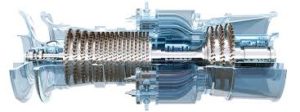 The report portrays the market in a positive light due to the push for renewable energies occurring in the world today. The researchers think that governments will invest more money into the gas turbine market in an attempt to integrate renewable energy technologies and to cut emissions.
The report portrays the market in a positive light due to the push for renewable energies occurring in the world today. The researchers think that governments will invest more money into the gas turbine market in an attempt to integrate renewable energy technologies and to cut emissions.
Anju Ajaykumar, a lead analyst at Technavio, talking about the report, said: "Worldwide, power generation is undergoing a transformation from centralized systems to integrated networks due to growing reliance on distributed power generation systems. Distributed power technologies are less than 100MW in size with the standard size being less than 50MW, which is the limit permitted by distribution systems at distribution voltages."
The research underlines which markets are directly affecting the rise in the need for gas turbines:
- Power generation 70.39%
- Mobility 17.18%
- Oil and gas 6.07%
- Others 6.35%
"Gas turbines are an essential part of distributed power technologies product portfolio along with diesel and gas reciprocating engines, solar panels, fuel cells, and small wind turbines. Thus, growth of distributed power systems will translate to an increased demand for gas turbines during the forecast period," Ajaykumar concluded.
Back in 2012, General Electrical debuted 60 Hz gas turbines named FlexEfficiency and since then have seen new orders flying in. Toshiba has recently asked GE's Power Services to retrofit steam turbines in their steel manufacturing facilities in South Korea. The power plant would recycle the steel facility's blast furnace gas and use that to fuel boilers to create steam. The method is an environmentally conscious method, the company says no harmful gases will enter the atmosphere. When launched, GE said their gas turbines would avoid up to 56,000 metric tons of carbon emissions per year.
Siemens - who also have a range of gas turbines - were contacted by Israel to install two natural-gas fired turbines in a power plant. They will be installing their SGT-800 industrial gas turbines which have a capacity of 70MW each. They will also be installing one in Malaysia.
- Details
- Written by: Quintus Potgieter
- Category: Developments
Australia is set to conduct the largest trial of combined solar and energy storage in a suburb known as Salisbury. The company behind the endeavor is an energy company known as SA Power Networks . They will be supplying Tesla PowerWall or Samsung batteries for the lucky few who will get to see what the future of sustainable energy during peak hours without the grid's help looks like. The trial will see 100 houses get battery storage systems. SA Power Networks says that the customers can be expecting savings of USD$500 per year.
SA Power Networks is banking on energy power storage in Australia in a big way. They have made an easy-to-understand animation to explain the benefits of energy storage. It's quite convincing:
New Zealand is also seeing an upsurge of battery storage systems. Voxy confirms that Alpine Energy has been working with Infratec Ltd to bring the first grid-connected commercial energy storage systems to assist with clean energy production in the country. They will also be trialing the technology to test its viability as an answer to renewable energy.
Alpine Energy's General Manager Sara Carter said: "We have engaged in the BESS project in order to embrace the possibilities that future technologies can bring to the delivery of our core business and the sustainability of our community...With battery storage technology decreasing in price faster than originally predicted, the future uptake of the technology is likely to be significant. The trial will therefore also create an increased understanding of how customer deployed battery storage might impact on an electricity network in New Zealand."
In the United States, 18.3 megawatts of "grid-interactive" energy storage was installed in the first quarter of 2016. This was according to research conducted by Green Tech Media research and the Energy Storage Association. It is called the U.S. Energy Monitor study. Interestingly, less energy storage was deployed in the first quarter of 2016 than the entire 2015.
"The slow start to 2016 is not unusual, but also points to the shifting nature of U.S. energy storage market. After the rush to build and commission systems in PJM to meet the interim cap in the second half of 2015, this year is likely to see a move toward California as the leading market even for the utility-scale segment. This transition will undoubtedly be hastened by gas shortages in Southern California caused by the Aliso Canyon gas leakage and resulting energy storage procurement," said Ravi Mangani, GTM Research director of energy storage and the compiler of the U.S. Energy Monitor.
- Details
- Written by: Quintus Potgieter
- Category: Education
As the Internet of Things grows and grows, it continues to contribute to the fourth industrial revolution, connecting appliances all over the world to networks that are vulnerable to hackers. Getting your Masters of Science in Cybersecurity Engineering could be getting you a good looking salary in the world of today. Furthermore, professionals are encouraging students to consider going into cybersecurity due to the skills gap prevalent in workplaces today.
 Shockingly, according to the National Cyber Security Alliance of the U.S., 67% of millennial men and 77% of women say that they were never told what the word 'cybersecurity' meant and were never educated on the career prospects in cybersecurity when they were in middle or high school.
Shockingly, according to the National Cyber Security Alliance of the U.S., 67% of millennial men and 77% of women say that they were never told what the word 'cybersecurity' meant and were never educated on the career prospects in cybersecurity when they were in middle or high school.
IBM estimates that in 2015, there were 4,000 cyber attacks and $18 billion in credit card fraud. IBM's Watson (the company's cognitive - almost life like - computing system) will be instrumental in fighting cyber crime. IBM has launched 'Watson for Cyber Security' and will be tested out at eight different universities in the United States. IBM is hoping this will fill the current skills gap with the application that will scan through text to find threats lurking in areas of sites on the internet.
The U.S. Bureau of Labor Statistics says that security analysts positions will grow by 18% in the next year. The annual salary that they can look forward to would be $90,120 annual with a bachelor's degree. Not too shabby.
"Employers look for and typically require around five years of experience for security engineers but potential employees find experience hard to come by since there are few internships," Amy Justice, senior security and compliance consultant at SDGblue, told Lane Report.
"The demand for cybersecurity has increased greatly in the last few years. There have been a large number of public data breaches...There are also a lot of rumors about banking breaches. The next big hacking targets will be cars, medical devices, and home security devices. Everything on the internet can be hacked," said James Walden, associate professor and director of the Center for Information Security at Northern Kentucky University.
Check out these cybersecurity courses:
John Hopkins Engineering Master of Science in Cybersecurity
Here are more links to courses for Masters Degrees in cybersecurity:
- Details
- Written by: Quintus Potgieter
- Category: Developments
Elon Musk, CEO of SpaceX and Tesla visited the Pentagon on Wednesday. He met with Secretary of Defense, Ash Carter, according to CNN. Allegedly, the two were meeting to chat about "innovation". Musk would be hoping to cement more government ties for SpaceX as a company, they already have upcoming missions with NASA's assistance in 2018. It could also be about the Gigafactory that is soon to open in the Nevada desert that will see some of the most sought after electric cars released from its engineers' hands soon.
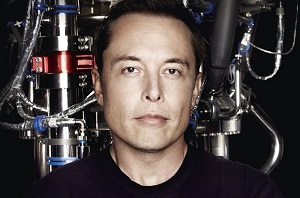 Elon Musk made hearts skip a beat when he tweeted about the meeting. He tweeted that the meeting he attended was to talk about a "flying metal suit". It has been a recurring joke that Elon Musk is the Tony Stark of the real world. His advances in the world of engineering have made him a candidate for the nickname of Real World Iron Man.
Elon Musk made hearts skip a beat when he tweeted about the meeting. He tweeted that the meeting he attended was to talk about a "flying metal suit". It has been a recurring joke that Elon Musk is the Tony Stark of the real world. His advances in the world of engineering have made him a candidate for the nickname of Real World Iron Man.
Nonetheless, SpaceX has a contract with the US Air Force that will allow the company to launch a GPS satellite in May 2018. The agreement will see SpaceX earning $87.2 million. So, maybe that's what they were talking about.
Something about a flying metal suit...https://t.co/6Z1D9iZ1fV
— Elon Musk (@elonmusk) June 9, 2016
Then a fellow Twitter-er, @AdamHuet, asked Elon Musk if he liked being referred to as a "billionaire" based on the CNN article calling him, "Billionaire Elon Musk." Musk's response was, "No."
Musk also confirmed that the batteries the Tesla Model 3 would be using were Panasonic and not Samsung batteries as some news sources have published.
Elon also gave Apple props at the recent Recode Conference. Apple has been recruiting some of Tesla's former engineers for what analysts are assuming is an electric vehicle. But Musk thinks they are too late to the game. He said: "I think they should have embarked upon this project sooner actually. I don't think they'll be in volume production sooner than maybe 2020. That'll be like the soonest."
"No, you know, it's just a missed opportunity...I think they'll probably make a good car and be successful; the car industry is very big, so it's not as though there is one company to the exclusion of others. I mean there's like a dozen car companies in the world of significance. And the most that nay company has is approximately 10% market share. So it's not like somebody comes up with a car and they're suddenly like -- they kill everyone else," Musk added.
You can see him talk about the aforementioned topic and more in this hour long conversation with Recode:
- Details
- Written by: Quintus Potgieter
- Category: Industry
Royal Dutch Shell will be investing less into LNG starting this year. The intention to slow down on investment into liquefied natural gasses will continue towards 2020, insiders in the company have confirmed.
"Integrated gas, which was previously a growth priority for Shell, has reached critical mass following the BG acquisition...particularly in Australia. The pace of new investment will slow here," said Shell chief executive Ben Van Beurden.
 Shell bought rival BG Group (a group known for its LNG sales) for $50 billion. After the purchase, Shell said it would "limit spending" on new projects. There is an impending $40 billion project in Canada that still needs to happen, however, analysts are saying it could be postponed.
Shell bought rival BG Group (a group known for its LNG sales) for $50 billion. After the purchase, Shell said it would "limit spending" on new projects. There is an impending $40 billion project in Canada that still needs to happen, however, analysts are saying it could be postponed.
Shell will be exiting 5 to 10 countries to further cut spending, under the oil crisis the world currently finds itself in. They are now moving closer and closer to shale oil and gas production and renewable energies. This would leave Australia - now one of the biggest LNG producers - without major investment in LNG.
"There is a view that says if we wait, we don't have to do anything because the demand of the developing world will grow...and if we turn off coal power stations, gas demand will go up, and next year's conference will be a rosy one. Well, nothing could be further from the truth. Simply surviving is not an option...we must change to grasp the opportunity in front of us," said Woodside Petroleum chief Peter Coleman, talking to a crowd at the Australian Petroleum Production and Exploration Association in Woodside.
"LNG is still a segment that strongly supports reinvestment. But LNG moves in fits and starts and it demands investment in big lumps," Van Beurden said.
Coleman further berated the Australian LNG industry for investing into the wrong areas. LNG projects topped $200 billion in investment in the last ten years. He said: "While we may wax lyrical about the $200 billion, it actually started as $100 billion. We shouldn't be proud of the $200 billion. We didn't deliver on our promise, we've delivered a very expensive energy source."
Source: The Australian / Reuters
- Details
- Written by: Quintus Potgieter
- Category: Developments
How do we get wind turbines into deeper water in the ocean? The answer is gravity base foundations. A company named EDF Energy Renewables has awarded a UK company, Royal BAM Group, the engineering design contract to build five gravity base stations that will keep wind turbines in Blyth, Northumberland, England propped up. The turbines would produce clean energy to 33,000 homes. Wind turbines are nothing new, but the gravity base stations are. They will be the first of its kind in the world.
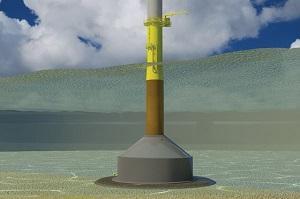
EDF Energy Renewables has crafted these foundations to use technology that they have claimed to be "self-installing". A single base's diameter will be 30 meters and filled with water inside of it. They are then lowered into the ocean and then filled with sand. The turbine is then ready to be lowered into the foundation base.
BAM's head of civil engineering Malcolm Corlett said: "This is a very significant milestone not just for BAM but for the wider offshore wind sector. An opportunity to demonstrate the potential for self-installing concrete gravity bases to provide economic foundations for large wind turbines in deeper water. Following five years of intensive work refining our design and method of construction we now have a live project to demonstrate our technology and bring new skills and opportunity to the northeast of England."
According to their video, EDF would make it easy to fill the foundations with sand on land, or pump sand into them once secured underwater. It is called 'float and sink' technology. This is where the foundations are floated and then sunk into position.
The chief executive of RenewableUK Hugh McNeal said: "The Blyth project highlights how Britain is leading the way in offshore wind innovation. Our industry is at the forefront of developing renewable technology that will be exported around the world."
The turbines will supply added energy to Blyth's 99.9MW offshore wind development projects, run by EDF Renewable Energies.
To see how these bases will be engineered in a construction yard alongside the ocean, look at this video:
Source: Construction Index UK
- Details
- Written by: Quintus Potgieter
- Category: Industry
Australian construction had a slow May, according to the Performance of Construction Index. The country dropped 4.1 points down to 46.7. A good construction month is usually past the 50 point mark. The measurements are done by an Australian company known as the Ai Group (Australia Industry).
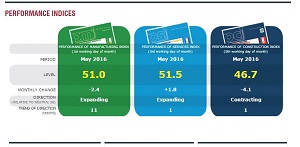
Ai Group, however, did indicate that apartment building and commercial construction was the hardest hit with losses in the research. The group confirmed that the lack of new orders has caused the fall, and it is the most significant fall since February 2015. Australia joins Britain who is also struggling to improve the number of orders in construction.
Ai Group did, however, confirm that manufacturing in May was down by 2.4 points but remained above the 50 point comfortability barrier.
Britain
Interestingly, British manufacturing might be improving despite subpar construction numbers due to the impending EU Referendum. It is a slow improvement due to the numbers that turned for the worst during the first quarter of the year.
EEF chief economist, Lee Hopley, spoke to Reuters, saying: "While all of this suggests that manufacturing is coming out of the mire of the past 18 months, even a decent six months in the latter part of the year will still leave output broadly flat over 2016 as a whole. If however a vote to leave the EU, we can expect a very significant period of political and economic uncertainty which will see the sector facing uncharted waters for some time to come."
So, if Britain exits the EU it would damage the improvement that manufacturing is currently seeing. If true, this would mean even more losses of jobs in the manufacturing industry which has already lost 385,500 since 2008, a study confirmed.
Source: The Australian / Reuters
- Details
- Written by: Quintus Potgieter
- Category: Education
Good news for engineers in the automotive industry! General Motors is rumored to be adding 1,000 engineering jobs in Ontario, Canada. These engineers will be involved in developing self-driving technology, cloud-connected car technology, and other projects GM might be busy with. An unidentified source - who spoke to the Globe and Mail - confirmed the rumors saying that the Oshawa branch would get 300 new engineering jobs, whilst the Markham branch would get 700 new jobs, all in Ontario.
Time to move to Ontario, it seems. The company was pushed for comment, however, all they replied with was: "On June 10th, GM Canada will be making an announcement at our Canadian Engineering Centre." If the rumors are true, it is good news for qualified engineers who are looking for work in the automotive field. The Prime Minister Justin Trudeau will be attending the ceremony, so it's a big deal. It is a particularly important announcement due to the fact that GM has been spending some of its $750 million in research and development money in getting more engineers on board.

The company currently employs 9,000 people in Canada.
Further afield, in the United States, it was reported that only 38,000 new jobs were made available in April, meaning that engineering jobs were few and far between last month. However, one branch of engineering was projected to do very well in the upcoming years. The New York State Department of Labor said that electronics engineers would see an employment increase of 2.8% between 2010 and 2022. This translates to 20 annual openings a year, in New York alone.
Elsewhere in the United States, San Diego is need of civil engineers. At a recent conference named Emerging Careers for 2016, the state expressed its need for the engineers. Brooke Emery, assistant project manager at the California Department of Transportation said: "Civil engineers will be needed to manage projects to rebuild bridges, repair roads, ports, railways, and upgrade levees and dams. Quality of life and safeguarding the environment are important and will continue to become more prominent. As the population continues to grow, civil engineers will also be needed to make the infrastructure multimodal and more suitable to mass transit."
Source: Democrat & Chronicle / CBC News
- Details
- Written by: Quintus Potgieter
- Category: Education
The World Economic Forum (WEF) released their 'Global Challenge Insight Report' document that dealt with the future of jobs in the world and how jobs would be changing from present day to 2022. The report was named The Future of Jobs: Employment, Skills and Workforce Strategy for the Fourth Industrial Revolution.
"Today, we are at the beginning of a Fourth Industrial Revolution. Developments in genetics, artificial intelligence, robotics, nanotechnology, 3D printing, and biotechnology, to name just a few...While the impending change holds great promise, the patterns of consumption, production and employment created by it also pose major challenges requiring proactive adaptation by corporations, governments, and individuals," said the Founder and Executive Chairman of the World Economic Forum, Klaus Schwab.

As a result, it is the World Economic Forum's opinion that by 2020, employment opportunities in several industries will no longer exist. Their research concluded that in the next 4 years, being a creative thinker, despite the industry you work in, will get you hired. Currently, being creative is 10th on the list of desirable traits in workers in several industries as defined by the WEF. The World Economic Forum believes it will be number 3 by 2020. Complex problem solving will be the number 1 skill wanted when doing a job in 2020. Hey, engineers, that's you.
Which degrees should you be studying to ensure that you are going to stay relevant in the fourth industrial revolution where so many repetitive tasks are being done by automated means? A study by the National Association of Colleges and Employers (NACE) in the United States cleared up which degrees might survive the test of time, or at least until 2022. They delivered questionnaires to college placement agencies and asked for feedback in terms of which degrees were getting the most hired in Bachelor's, Master's and Doctorate levels. Here is what they got back:
Top Degrees in Demand (Bachelor's Degree Level):
- Accounting
- Computer Science
- Finance
- Business Administration/Mgmt.
- Mechanical Engineering
- Information Sciences & Systems
- Electrical Engineering
- Logistics/Supply Chain
- Economics
- Marketing
Top Degrees in Demand (Master's Level Degree Level):
- Computer Science
- Electrical Engineering
- Mechanical Engineering
- Information Sciences & Systems
- M.B.A
- Accounting
- Finance
- Software Applications
- Computer Engineering
- Management Information Systems
Top Degrees in Demand (Doctorate Degree Level)
- Electrical Engineering
- Computer Science
- Software Engineering
- Computer Engineering
- Mechanical Engineering
- Chemical Engineering
- Maths/Statistics
- Systems Engineering
- Industrial/Manufacturing Engineering
- Physics
So, budding engineers. Probably a good idea to get your doctorate in electrical, computer, software, computer, mechanical, chemical, systems or industrial engineering, eh? The results show a pretty good picture in terms of degrees that are currently involved in industries where the fourth industrial revolution is actively infiltrating. You want to be the one working directly inside the fourth industrial revolution and not being one of the victims it replaces.
- Details
- Written by: Quintus Potgieter
- Category: Developments
The U.S. Food and Drug Administration (FDA) has given the greenlight to a robotics company named Auris Robotics. The company registered the ARES (Auris Robotic Endoscopy System) robot with the FDA, and they have finally been given the go-ahead to use the robot to work in the medical field.
Auris Robotics has their roots in another company named Intuitive Surgical who showed off their Da-Vinci robot surgical system The Da Vinci is a robot that has "tiny-wristed" instruments that can reach into the human body with the assistance of a doctor to get into hard-to-reach areas of the body.
Please note this video has actual surgical footage in it, viewer discretion is advised:
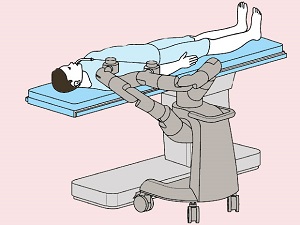
Now, Auris Robotics is wanting to build "the next generation of surgical robots". Interestingly, it seems the group is actively building endoluminal surgical robots. This means that they are building a non-invasive 'surgical' robot. The robot would not make incisions so that it can access internal organs. In the FDA's premarket notification, they specify that the medical uses the new robot will have, focus on ear, nose and throat. These robots are going to have to be incredibly precise if that is the case.
IEEE Spectrum has reported that the first human trial at the hands of the robot has already been successfully conducted. Fitted to the robot, are "lasers, forceps, needles, graspers, and scalpels", which the company says will probably be used once the robot gets clearance to do full-fledged surgeries. For now, these robots are controlled remotely by a doctor, however, when robots become automated surgeons, would you trust them to perform surgery on you? Let us know in our comments section.
- Details
- Written by: Quintus Potgieter
- Category: Education
In a recent study conducted by academic contributors to a website called Econotimes, it was found that in 80% of countries, girls experience negative emotions towards mathematics. The researchers claim females at a young age have anxiety towards STEM subjects and as a result, we see less and less female engineers in the world.
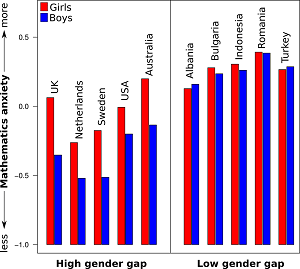
The research has been conducted since 2012 and now the results have been published in a journal titled: Countries with Higher Levels of Gender Equality Show Larger National Sex Differences in Mathematics Anxiety and Relatively Lower Parental Mathematics Valuation for Girls. The researchers put their findings into a graph (shown to the left of this article) that shows anxiety - in red - and where the most anxious students are, geographically.
The UK, the Netherlands, Sweden, the United States and Australia showed moderate levels of mathematics anxiety in girls. These are countries that have some of the greatest universities for engineering in the world. Meaning, if girls are anxious about mathematics at a young age, the chances of them getting into STEM careers later on in life is less likely.
"Most importantly and contra predictions, we showed that economically developed and more gender equal countries have a lower overall level of mathematics anxiety, and yet a larger national sex difference in mathematics anxiety relative to less developed countries," the researchers wrote in their journal.
The study was conducted with 761,655 respondents who were all 15 years old. If curriculums are altered so that less mathematics anxiety happens, perhaps equalizing the gender gap in engineering could actually happen.
Worryingly, female engineers are finding it difficult to join the workforce, especially in Australia. A study conducted by Engineers Australia showed that "half of female graduates in engineering do not enter the workforce." The other 50% that do enter the workforce reportedly leave the industry after 10 years. More shockingly, Engineers Australia says that less than 1% of Australian women past the age of 50 years old are currently working in the industry.
What is being done to bridge gender gaps in engineering?
The Mandarin writes that last year, 30% of engineers in Malaysia were women. Comparatively, the figure used to stand at 6% of engineers.
However, it all begins in the classroom at an early age. Can mathematics anxiety be minimized so that both males and females could look forward to STEM careers after school and university? Let us know what you think in the comments section.
- Details
- Written by: Quintus Potgieter
- Category: Developments
Microsoft's Hololens is one of the more impressive devices being engineered in the augmented reality world. However, Microsoft wants to do one better and integrate more virtual reality into the Hololens than previously advertised. They're now calling the Hololens a "mixed-reality" device that they hope will thrill consumers all around the world. The engineers have been working to bring an operating system to their Hololens as well. The new video they have released shows how far the company has come in terms of mixed-reality and virtual reality. The company showed off the new additions to Hololens at the Computex conference in Taipei.
The company has also confirmed that Microsoft Outlook is now available for the Hololens. The augmented reality uses could assist engineers in projects they are involved in, in the future. As you can see in the video, collaboration between two people working on the same project is becoming multi-faceted and easy with a virtual landscape/canvas to work on.
Microsoft confirmed that they are working with AMD, Acer, Dell, HP, Lenovo and more to bring their Hololens into the virtual reality world as well as display the already available augmented world applications. So, it is apparent that Microsoft is becoming more relaxed and lending their gear out for other companies to see what they can do with it. They will be opening up their platform to third parties.
One of the third-party applications that might convince engineers that they should buy a Hololens is the Autodesk Fusion 360 app. Working with CAD software is something engineers do on a daily basis and now with the ability to bring engineering design software into "mixed-reality", engineers could work more efficiently and practically. Now engineers can avoid making costly mistakes by first seeing what an engineering decision might result in, in mixed-reality.
To see how it would work:
- Details
- Written by: Quintus Potgieter
- Category: Education
32,000 Australian students opted to study overseas in 2014. These statistics were compiled by a group named Universities Australia. The study showed that from 2008 to 2014 the number of students who left Australia to study overseas grew from 15,058 students to 31,912 students. Where are they going? The report claims a lot do go to English-speaking countries but China has been a draw card for some.
The main destinations were listed
- The United States
- China
- Britain
- Canada
- Japan
 Scott Sheperd, deputy vice-chancellor at the Queensland University of Technology said: "Instead of going for an entire semester, a lot of students are now heading overseas for two to four-week programs. Students also benefit from the exposure to new experiences and increasing their resilience. And that shows to employers that they have a broader perspective."
Scott Sheperd, deputy vice-chancellor at the Queensland University of Technology said: "Instead of going for an entire semester, a lot of students are now heading overseas for two to four-week programs. Students also benefit from the exposure to new experiences and increasing their resilience. And that shows to employers that they have a broader perspective."
The Australian publication further showed students from 34 of the 39 Australian universities took part in "learning abroad" studies. The research showed that 30 percent of the students from these universities went to Asia. One of the researchers, Rob Lawrence, said that out of 6,800 he conducted research on the reasons given for studying abroad was because students didn't want a "run-of-the-mill degree".
An electrical engineering student, Matt Rowe, said studying abroad was good for him. He said: "It gives you the confidence to follow your interests, to seek adventure and to be excited by the ocean of experiences just waiting for you."
Are engineering students studying abroad and then snatching the degrees from the students that were actually born in the country? The Americans say: yes.
"It's a big concern: We bring a lot of students here, we train them, and then they leave," said Vince Bertram, President, and CEO of Project Lead The Way. According to research from the National Science Foundation and National Institutes of Health, the amount of U.S. citizens getting graduate degrees in science and engineering fell by 5 percent in 2014. The groups drew parallels with how many temporary visas were granted, which spiked by 35 percent in those years.
"We have to continue to expand our domestic pipeline of students going into these areas. We have to continue to grow our own talent, and it doesn't happen at the graduate level. It's going to occur at elementary and middle school, not trying to convince students once they're in high school that these opportunities are available to them," Bertram said.
- Details
- Written by: Quintus Potgieter
- Category: Education
What are the top universities to study at if you are serious about having a career in engineering? What are the top notch institutes that would definitely get you employment in the engineering industry? Times Higher Education says they have come up with the definitive top 10 list. They have ranked them according to their readiness to produce premium engineering education.
Unsurprisingly, the top 10 list names a lot of universities that have impeccable research and development laboratories where some of the world's new products are built in by alumni and student engineers alike.
10 - Carnegie Mellon University: U.S.A
CMU in Pittsburgh, Pennsylvania are on a list on the World Economic Forum's Global University Leaders Forum.
9 - Imperial College London: UK
According to University Herald, Imperial College London is the "highest ranking university in London in the engineering and technology domain."
8 - ETH Zurich: Switzerland
Named one of the best universities in the world for robotics engineering education. Researchers at the institute have recently made a walking dog robot. Marco Hutter, the engineer behind the dog, said: "In the field of robotics, ETH is one of the best universities in the world – if not the best."
7 - Princeton University: U.S.A
6 - University of Oxford: UK
One of the most famous universities in the world. Recently, they have started hiring additive manufacturing specialists to cement them as a university with the latest in 3D printing technology. The university has a world-class reputation with students across all faculties.
5 - University of California: Berkeley, U.S.A
When you think about Silicon Valley, you think about the engineers that come from University of California. A neuroscientist from the university has recently won an early-career award, showing that the university equips young minds with the tools to achieve.
4 - University of Cambridge: UK
Recently, James Dyson, the head of the Dyson company opened the Dyson Centre for Engineering Design at Cambridge. The centre cost $11.6 million to build. It furthers Cambridge as a university that will be bringing the best-designed products that will be engineered and ready for the mass consumer market.
3 - Massachusetts Institue of Technology (MIT): U.S.A
A discussion of best universities cannot be had without the mention of MIT. The university has a good rapport with big aerospace company NASA. Their robotics education has spawned some of the best robotics testings in the world, and they are currently testing out the robots that NASA intends to send to Mars in 2018. The university also recently showed off robots that can be swallowed by humans so that they can retrieve items that might have been accidentally ingested.
2- California Institute of Technology AKA CalTech: USA
Engineers from this university are so confident in their engineering designs that they are accusing Apple of stealing their WiFi technology . The engineers claim they have a patent on the technology that Apple is using in their devices.
1 - Stanford University: U.S.A
Our personal favourite on this site. Some of the most impressive feats of engineering are reported from this university. They boast the greatest engineering research and development. Notably, their biomedical engineering projects are constantly redefining what is possible with medicine and engineering. Recently, researchers developed a home-based urine test that can diagnose a patient with almost nothing but a smartphone.
- Details
- Written by: Quintus Potgieter
- Category: Developments
There's a new sheriff in town. It seems Dubai is wanting to be the leader in all forms of manufacturing and renewable energy lately. They have 3D printed full business offices and are now looking to build the world's largest solar power plant. This would eclipse the current record holder, Ivanpah Facility in California, that has recently seen a lot of technical difficulties and a tower-destroying fire.

The announcement came from the Dubai Water and Electricity Authority (DEWA) who promised to generate 1,000 megawatts of clean energy by 2020. Ivanpah currently does 392 MW. So, Dubai is aiming high. This will follow the same setup as Ivanpah does, which does not rely on photovoltaic cells but rather uses reflective mirrors (heliostats) to redirect sun energy to the main power tower that converts the concentrated light into heat with the assistance of a steam turbine.
The tower will produce power that only costs 8 cents per kilowatt hour, whereas the current rate for renewable energy is 15 cents per kilowatt hour. The average house uses 30KWh per day, so the plant is producing energy at a very low cost. According to DEWA the solar plant will be able to remove 6.5 million tons of carbon emissions from the country per year. Gizmodo reports that a coal plant produces 3.5 million tons of C02 per year.
They hope to have the plant completed by 2020 or early 2021.
"An advantage of CSP (concentrated solar power) is that thermal heat, which used to produce electricity, can be stored easily. This makes it possible to produce electricity after sunset," said Saeed Mohammed Al Tayer, DEWA's managing director, and chief executive officer. "The plant will have several thousand heliostats located around a tower which will receive the radiation reflected by the heliostats. The heat-transfer fluid is then used to power the steam turbine to generate electricity."
Let's just hope the plant doesn't go through the same troubles like the Ivanpah facility has gone through, such as lack of sun due to bad weather and heliostats reflecting into the wrong part of the tower causing fires. However, being in Dubai, we're certain that there is going to be more than enough sun to go around.
Solar technologies are becoming better and more efficient as time goes on. Here is a high-efficiency photovoltaic cell system that we could also soon be seeing in our daily lives:
- Details
- Written by: Quintus Potgieter
- Category: Developments
Engineers are the new pizza delivery guys. Home delivery robots will soon be delivering your pizza straight to your door without you having to talk to a human face, your pizza might even be warmer. Multiple pizza companies are the first to be introducing robotics into their businesses. We've seen the Pepper robot assisting with purchases at Pizza Hut. However, robots delivering pizza is a whole different ballgame.
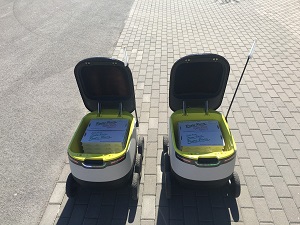 A team of engineers in Estonia, who have called themselves Starship Technologies has developed their very own pizza-delivering robots. Their prototype has sensors and a total of nine cameras built it into it. Starship believes automated robot delivery is the future of food delivery. The prototypes they have built are reportedly 90-99% automated. They will be testing 15 of their robots in London, Berlin, Tallin and Arkansas by the end of the year according to Forbes.
A team of engineers in Estonia, who have called themselves Starship Technologies has developed their very own pizza-delivering robots. Their prototype has sensors and a total of nine cameras built it into it. Starship believes automated robot delivery is the future of food delivery. The prototypes they have built are reportedly 90-99% automated. They will be testing 15 of their robots in London, Berlin, Tallin and Arkansas by the end of the year according to Forbes.
"This is about delivering parcels and groceries to people's doorsteps in the suburbs and this is an autonomously driving robot doing deliveries on a pavement. It's a very practical proposition actually, much more practical than doing deliveries using a self-driving car or using a drone for instance so this is actually lower cost than all those technologies," said Ahti Heinla, the man at the helm of Starship Technologies.
The Estonian team of engineers are not the only ones getting involved with robot-to-home delivery. Domino's Pizza has gotten involved as well. Domino's DLAB in Australia has revealed the Domino's Robotic Unit, or DRU, for short. Dominos' engineers were recruited from a start-up named Marathon Robotics. They acquired a robotic device formerly used by the military and began work on a pizza-delivering robot. The robot currently does 12 miles an hour. So, waiting for your pizza has just been extended based on where you live. The technology is being tested right now but we could see these pizza-delivering robots navigating our streets very soon.
Although, aren't these robots in danger of being stolen by criminals who want to harvest their parts or steal the food that is inside of them?
Heinla says he doesn't think it will come to that. In an interview with the BBC, he said: "People actually do not interfere with it on the pavement, we have driven thousands of miles with robots like this in London, Tallin, and the US and the vast majority of people just ignore it on the pavement."
- Details
- Written by: Quintus Potgieter
- Category: Developments
United States Navy Engineer Dennis Gallagher has developed an augmented reality (AR) helmet for navy divers. The prototype is sitting at the US Navy's Naval Surface Warfare Center Panama City Division (NSWC PCD) and utilizes the same head-up display principles that aircraft in the US military use today. The helmet has HUD technology embedded into it, says the Navy.
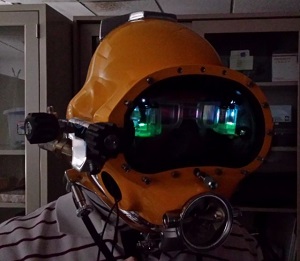
It is called the Divers Augmented Vision Display (DAVID) and will revolutionise the way Navy divers conduct their dives. Gallagher belongs to the Underwater Systems Development Project that develops new technologies for the US navy.
"By building this HUD directly inside the dive helmet instead of attaching a display on the outside, it can provide a capability similar to something from an 'Iron Man' movie. You have everything you visually need right there within the helmet," Gallagher said.
The helmet will be able to give real-time updates on a visual display. Updates that pertain to "sonar, text messages, diagrams, photograms and even augmented reality videos," the engineers confirmed. The new helmet could ensure the safety of divers during operations by giving divers accurate underwater navigation to hard to reach areas. The Navy also says the helmet will assist with "underwater construction and salvage operations" and foresees a future where consumers could buy diving masks with augmented reality built in based on this prototype.
The first tests of the helmet will be conducted in October.
Source: America's Navy
- Details
- Written by: Quintus Potgieter
- Category: Industry
Engineering companies sometimes lose their staff to other engineering companies. We've seen it happen frequently inside the engineering teams of Apple and Tesla, where engineers resign and move on to 'greener pastures'. A recent management change within Cisco Systems Inc. - who are wanting to become the leaders in Internet of Things technology - has made four of its top engineers resign from the company. Mario Mazzola, Prem Jain. Luca Cafiero and Soni Jiandani were supposedly the research and development dream team for Cisco but have now decided to part ways with the company.
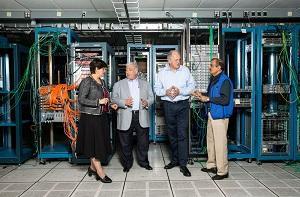
The group was in charge of the design of products that Cisco recently bought into called "spin-in" products that saw the engineers getting big paycheck raises based on technology they sold to the company. A former executive at Cisco the engineers saying: "Mario is the soul. Luca is the brain. Prem is the heart. And Soni is the mouth." Some went as far as to say that the group ARE Cisco, due to the amount of tech they had built for the company and the amount of tech the company bought from them. However, they do hold office job positions at Cisco as well.
The engineers had a rare deal with Cisco. Their involvement in Cisco involved creating a start-up company, developing hardware and software and then selling it to Cisco and making a lot of profit. This is the idea behind the "spin-in" technologies. Budding engineers, take note.
Business Insider recapped the amount of money Cisco paid every time the group of engineers built a start-up company and then sold the technology they built :
- $750 million in 2001 for storage networking switches under company name Andiamo Systems
- $678 million for a "new kind of server" technology in 2008 under company name Nouva Systems.
- $863 million for a "core networking product" under company name Insieme Networks.
The four's positions in the company were shuffled just as June started. They were given advisory positions in the company by CEO Chuck Robbins in an internal memo.
However, it's all over now. The four have resigned from Cisco and are probably on their way to sipping on cocktails on their yachts, due to being multimillionaires as a result of Cisco's investment into their technology. However, if this isn't an engineering success story, we don't know what is.
- Details
- Written by: Quintus Potgieter
- Category: Education
Engineering careers are far and few between in the United States. The Labor Department in the country said that only 38,000 jobs across all industries were added in the last month which would be the lowest growth numbers in the last five and a half years.
The industries that particularly struggled to employ any new employees were engineering fields. Construction, manufacturing, oil and gas industries saw the biggest losses in May. Capital Economics Chief economist, Paul Ashworth said: "The weakness in May's payrolls was widespread. Manufacturing lost 10,000 jobs, construction shed 15,000 jobs and temporary help fell by 21,000. A June rate hike from the Fed is now very unlikely."
 "The bad news with this jobs report is that if the U.S. slows, that means Dallas will slow, which has really been the anchor for growth. The parts of Texas that have been growing the fastest and doing well despite the energy bust will be impacted by any slowing of the national economy," said Pia Orrenius, an economist at the Dallas Federal Reserve, talking to the Houston Chronicle.
"The bad news with this jobs report is that if the U.S. slows, that means Dallas will slow, which has really been the anchor for growth. The parts of Texas that have been growing the fastest and doing well despite the energy bust will be impacted by any slowing of the national economy," said Pia Orrenius, an economist at the Dallas Federal Reserve, talking to the Houston Chronicle.
The data gathered suggests that 207,000 jobs have been lost in America since September 2014. Mining and logging industries recently contributed 10,000 losses to that number.
However, TechServe Alliance, a company that offers research into the IT & Engineering Staffing and Solutions industry have said that engineering employment improved across the board by 0.1 percent in April. The researchers pointed out that from April 2015 to April 2016 engineering employment in the United States actually did increase by 0.8 percent, but adding only 21,100 engineering jobs.
"IT employment continued its steady but unremarkable growth in April. On the engineering side, we saw the return of modest growth after ticking down the prior month. While there remains an air of uncertainty, we continue to see hiring in many technical skills sets continue at a solid pace. Employers and the employment market are not monolithic. While we are seeing weak demand in some industries, other industries such as management and technical consulting are showing remarkable strength," said Mark Roberts, CEO of TechServe Alliance.
- Details
- Written by: Steve Mackay
- Category: Blog - Steve Mackay
Even as long ago as the 1970's, our engineering school saw massively declining enrolments in power systems engineering. Everyone wanted to undertake the high tech type electronics and software type courses. Students were unexcited by power engineering as they perceived it to be old, inflexible and industrial ‘smoke stack’ type engineering.
Dear Colleagues
Even as long ago as the 1970's, our engineering school saw massively declining enrolments in power systems engineering. Everyone wanted to undertake the high tech type electronics and software type courses. Students were unexcited by power engineering as they perceived it to be old, inflexible and industrial ‘smoke stack’ type engineering. As students we were rather daunted by working with gigantic pieces of switchgear and generating sets (can anyone remember ‘Ward Leonard’ generation?). Software and electronics seemed infinitely more sexy and something you could control. Power engineering overlapped with mechanical and civil engineering (think of the giant bearings for a generator or the transmission towers striding across your landscape).
Of course, this is not the case at all today.
Today, three things are happening to change power engineering:
- Green technologies are transforming generation (and storage), transmission, distribution technologies
- Power engineering professionals are starting to retire (or at least go part-time)
- There are minimal new entrants to “classical” power engineering
I think we all know that there is considerable uncertainty about government regulation in terms of the green technologies (e.g. the debate on the ‘carbon tax’ and charges for power from Photovoltaic Cells). This will have a considerable impact on the precise mix of the various technologies that are used.
Almost half of the power engineers at US electrical utilities will be eligible for retirement in the next few years. And seemingly over 70% of engineering college faculty in power engineering are close to retirement age. I am always startled by the number of older retired engineers (well, I shouldn't be) who look on puzzled when you ask them to work longer hours than the 10 odd part time hours they are doing every week. The additional money is meaningless in most cases and unless it is stimulating work, full of fun or capable of some serious contribution to people, society or the environment, they often lose interest.
It is quite amazing how many universities and colleges have partially or totally shut down their power engineering programs. All of this know-how leaving us.
Fortunately, power engineering today is almost unrecognizable from 20 years ago, with a strong emphasis on software, electronics, communications, if you think of the infinitely varying requirements of the smart grid. The smart grid makes the new power grid very similar to the internet. A lot of investment in smart grids involves fiber and wireless networks. Although these skills are important, the traditional skills of power engineering are still vital. The ability to create an efficient power system design is very important. Solar and wind energy farms are often located far from the customers and this makes for more design challenges.
So, it is now vital to be re enthused with the opportunities for career and work possibilities in the ‘new’ power engineering and the contribution you can make as an engineering professional.
Perhaps, we should treat the power industry along the lines John F. Kennedy remarked: The Chinese use two brush strokes to write the word 'crisis.' One brush stroke stands for danger; the other for opportunity. In a crisis, be aware of the danger - but recognize the opportunity.
Thanks to John R.Platt from the IEEE for a thought provoking article and the Economist for more on renewable energy.
Yours in engineering learning
Steve
Mackay’s Musings – 7th June’16 #603
780, 293 readers – www.eit.edu.au/cms/news/blog-steve-mackay
- Details
- Written by: Quintus Potgieter
- Category: Industry
India
India is hiking their investment into renewable energy from its current $72 million to a handsome $145 million over the next five years. They are currently participating in what is called the Mission Innovation. A movement that holds countries accountable in terms of accelerating global clean energy. To see which countries have pledged their support for eliminating greenhouse gases, see the photo attached to the left of the article.
"Mission Innovation is the noblest mission which will help humanity. This has also touched the heart and soul of our Prime Minister. With super-efficient air conditioners, we can reduce the energy demand from 60 Giga Watts of energy to 40GW, a saving of 30 per cent. This translates to cost savings in consumer energy bills of $2.8 billion and GHG reductions of 20 million tons of C02 equivalent," said Union Minister for Science and Technology Hars Vardhan.
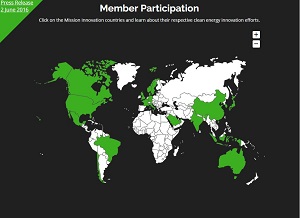
Australia
In Australia, the Greens party has launched a clean energy policy that will see solar technology being fairly priced so consumers can access it. Their policy would ensure $192 million would be funded for installing photovoltaic cells in schools as a "right to solar" so that schools can be powered by renewable energy. The solar policy is being considered brave by some critics, in a situation where Australia is trying to lead the charge for solar expansion.
The Greens are also trying to prevent any fees or charges that the government would try to impose due to the usage of solar technology. Their policy guards homes and businesses from fees "likely to be imposed by electricity networks clawing back their diminishing revenues as our electricity system decentralises and consumers become empowered."
The party is currently trying to move Australia into a country powered by 100% renewable energy by 2030.
Source: Mission Innovation / The Guardian
- Details
- Written by: Quintus Potgieter
- Category: Developments
Daimler/Mercedes
Mercedes producer, Daimler, is fresh off of releasing their new home and businesses powering lithium-ion batteries to Germany and have now created a dedicated branch that will assist with further innovation in the energy sector. The new entity's name is Mercedes-Benz Energy GmbH. The entity will be leading the charge in the sales of the brand new batteries by Daimler.
 "This now enables us to respond with even greater flexibility to our customers' requirements," said Harald Kroger, Head of Development Electrics/Electronics and E-Drive at Daimler AG. This means that the Mercedes batteries should be closer to global deployment, meaning you could have one on your wall very soon.
"This now enables us to respond with even greater flexibility to our customers' requirements," said Harald Kroger, Head of Development Electrics/Electronics and E-Drive at Daimler AG. This means that the Mercedes batteries should be closer to global deployment, meaning you could have one on your wall very soon.
"With growing electrification of the automobile, demand for lithium-ion batteries is constantly rising. By expanding this line of business to include stationary private and industrial applications, Daimler AG with its wholly owned subsidiary Deutsche ACCUMOTIVE GmbH & Company KG are already opened up additional prospects for growth last year. Delivery of domestic storage solutions for the Germany market started in April," the press release for the company said.
The hope is that Mercedes' new lines of cars will also benefit from the battery technology and release something that could be considered a competitor to the Model S that will be released from Tesla in 2017/18.
Tesla
A new study into the viability of the lithium-ion batteries that are available in Tesla vehicles has been conducted. The results are very positive. The potential battery capacity degradation was studies and shows that the Model S' battery pack loses only 5% of its capacity within 50,000 miles. This could mean great things for the reusability of these batteries once they have gone through their legal cycles in the car. It could mean that you could use a secondhand battery from a Tesla vehicle to use as a Tesla PowerWall, in the same way that Nissan is currently advertising their home-powering battery.
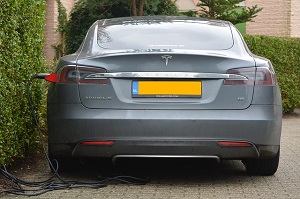 According to Electrek, Tesla's cars come with 8 years of battery warranty no matter how far you drive them. Elon Musk was quoted when announcing the warranty, saying: "Moreover, the warranty extension will apply retroactively to all Model S vehicles ever produced...If we truly believe that electric motors are fundamentally more reliable than gasoline engines, with far fewer moving parts and no oily residue or combustion byproducts to gum up the works, then our warranty policy should reflect that."
According to Electrek, Tesla's cars come with 8 years of battery warranty no matter how far you drive them. Elon Musk was quoted when announcing the warranty, saying: "Moreover, the warranty extension will apply retroactively to all Model S vehicles ever produced...If we truly believe that electric motors are fundamentally more reliable than gasoline engines, with far fewer moving parts and no oily residue or combustion byproducts to gum up the works, then our warranty policy should reflect that."
So lithium-ion rules once again in the powering of electric vehicles and is here to stay. Encouragingly, the strength of the Model S' impending battery bodes well for people who have installed Tesla's grid-balancing PowerWall in their households. It seems more and more automakers are vying for spots on your wall to power your house, and to power your car with a battery instead of a carbon emitting engine. Who get's your vote?
Source: Clean Technica
Blog - Steve Mackay
EIT's Technical Director, Steve Mackay, enjoys keeping his blog up-to-date with useful tips and current industry matters for his fellow colleagues. He has a loyal and expanding following base reaching over 300,000 people around the world.
Student Stories
In this section you have the opportunity to read and listen to EIT students talking about the reality of the programs. Discussions are wide-ranging and include information about the study commitment required, the value of the qualification in their careers, the relevance of the subject matter, future pathways, and more. They provide valuable feedback for you to take into account before you decide to join one of our programs.
Career Information
Latest career information including industry research, podcasts, blogs, life hacks and general information about how you can make the most out of your career.
Education
Here you will find out more about the latest trends and developments within education worldwide, along with some helpful articles regarding study tips and keeping on track with your studies.
Developments
The latest innovation and inventions from the world of engineering can be found here. Learn about advances in technology and how they can make a real difference within your industry.
Announcements
Keep up to date with the latest announcements from the Engineering Institute of Technology. In this section you can read more about new courses, new recognition from professional bodies, our Excellence in Teaching Award, upcoming free webinars and much more.
Monthly Update
We understand that you may not have time to read all the articles that we post, so our monthly update gives you access to some fascinating articles which cover the best of the months news in a compact format.
Engineering Resources
The key objective of the Engineering Institute of Technology is to provide outstanding practical engineering and technology education. Together with several industry and educational partners we gladly share the following resources and information to assist you along your professional development path. Please note that some of the articles will open a new internet browser tab and redirect you to other partner websites.
